SCIOS
supporting the botanical literacies of young children and their teachers
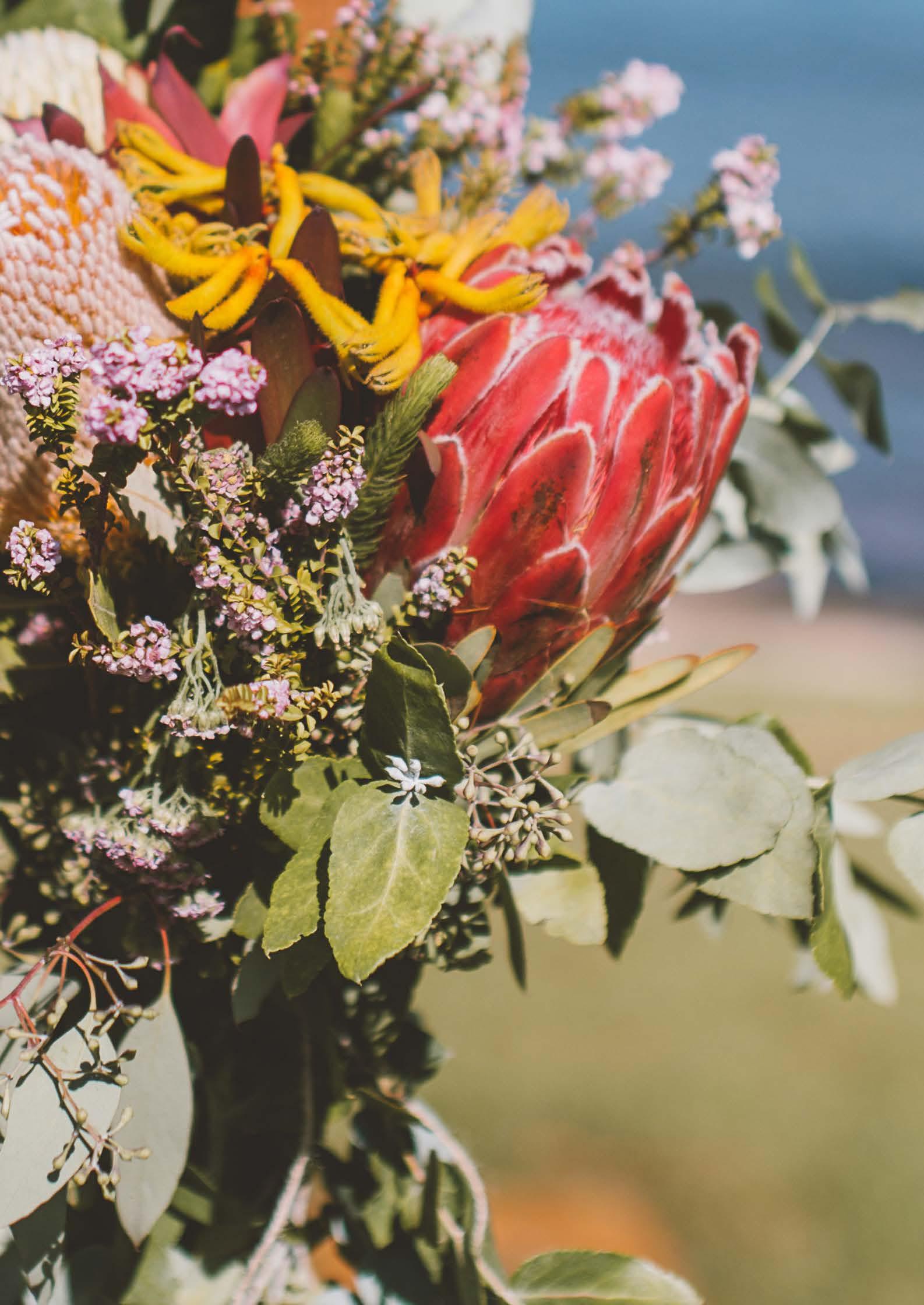
JOURNAL OF THE SCIENCE TEACHERS’ ASSOCIATION OF WESTERN AUSTRALIA VOLUME 69 MARCH 2023
SCIOS: To Know
This journal aims to promote the teaching of science with a focus on classroom practice. It provides a means of communication between teachers, consultants and other science educators. Opinions expressed in this publication are those of the various authors and do not necessarily represent those of The Science Teachers’ Association of Western Australia (STAWA), the editorial committee or the publisher.
STAWA Office
Unit 6, 10 Mallard Way, Cannington WA 6107
Contact Tel +61 (0) 8 9244 1987
Fax +61 (0) 8 9244 2601
Email info@stawa.net.au
Web www.stawa.net.au
Editorial Committee
Bailey Brown
John Clarke - STAWA
Mady Colquhoun
Allan Knight
Lyndon Smith
Editorial Correspondence info@stawa.net.au
Graphic Designer
Kattie Muir - Digital Crayon
Advertising Enquiries
Tel +61 (0) 8 9244 1987
Fax +61 (0) 8 9244 2601
Email info@stawa.net
© 2023 The Science Teachers’ Association of Western Australia (STAWA). All rights reserved. No part of this publication may be reproduced or copied in any form or by any means without the written permission of STAWA. Unsolicited material is welcomed by the Editor but no responsibility is taken for the return of copy or photographs unless special arrangements are made.
ISSN 0157-6488
CONTENTS
Editorial
From the President
Chief Executive’s Report
Being a Junior Bush Scientist
VOLUME 69 | MARCH 2023 JOURNAL OF THE SCIENCE TEACHERS’ ASSOCIATION OF WESTERN AUSTRALIA PAGE 2
Cover Image photo by Rachel Claire: https://www.pexels. com/de-de/foto/blumen-blauer-himmel-grune-blatterbanksia-5531607/
in
Bushland or School Garden! Reviving Botany in the Curriculum Utilising Local Native Bush Species First LEGO League Primary Science Committee Coffee Catch-ups Safety in the Primary Science Laboratory Charging into a Battery-Powered Future What can the Chief Examiner Teach Us? Science Talent Search Book Review STAWA Membership How to Contribute 3 5 7 9 13 24 29 31 34 38 41 44 45 46
your Local
Welcome to the first edition of SCIOS for 2023. The cycle of the school year has once again begun with teachers and students settling into the rhythm of the school year. Teachers are getting to know their students and students their teachers. Similarly, the SCIOS editorial committee would like to get to know our readers better so we are inviting you to complete a brief survey to tell us what sort of articles you would like to see in SCIOS (see page 4).
In reflecting on some of the articles that are included in this first issue of SCIOS for 2023, the theme of cycles recurs. Primary school teacher Cathie Donaldson shares her experience of delivering science content and Science Inquiry Skills through engaging her students with local bushland. Students learn of annual cycles through regular bush visits over the school year as well as learning about the water cycle and how nutrients move through the ecosystem in food chains. The activities also allow the Cross-curriculum priority Aboriginal and Torres Strait Islander histories and cultures to be addressed through learning of the Noongar seasons and some of the traditional uses of local plants by Aboriginal people.
Kimberley Beasley introduces the concept of botanical literacies in her article about reviving botany in the curriculum by utilising local bush spaces also providing opportunities to explore Aboriginal and Torres Strait Islander histories and cultures. She provides a
EDITORIAL
Allan Knight

yearlong plan for including botany in the curriculum for early childhood which links activities to the Science Inquiry Skills in the WA Curriculum outline. These two articles offer the opportunity for teachers to cultivate in their students an enjoyment of bush spaces which can help young people value our remaining bushland and so may contribute to their sustainability.
This issue includes an article about a possible future role for WA in the lithium industry and lithium-ion batteries. The article provides a practical example through which aspects of both the oxidation and reduction principles in the Year 12 Chemistry syllabus and electric power principles in the Year 11 Physics syllabus can be applied. Lithium batteries can also offer a view of cycles from a redox reaction perspective. Lithium-ion batteries can be recharged following their discharge when used to power devices. This cycle of discharge and recharge can continue for multiple times as we well know from our use of contemporary mobile devices. It is this capacity to cycle between discharge and recharge that makes these batteries potentially very valuable for storing energy produced from renewable sources such as solar and wind and this is addressed in the article. The article also discusses the need for a growth in the scientific workforce to support new lithium hydroxide and nickel sulfate refineries in WA, and other battery related industries.
PAGE 3 VOLUME 69 | MARCH 2023 JOURNAL OF THE SCIENCE TEACHERS’ ASSOCIATION OF WESTERN AUSTRALIA
SuRvEy
What do you, our readers, want in SCIOS?
The Science Teachers’ Association of WA began publishing SCIOS in 1965, so in 2023 we begin its 58th year of publication.
Recent issues of the journal have included “From the Archives” articles, sometimes highlighting how much has changed but also how familiar certain topics are. Understanding how we have arrived at our present circumstances is important, as is getting a sense of where we would like to head.
To this end, the new editorial committee for SCIOS felt it is timely to hear from you, our readers. So, we are asking teachers of science and other readers of SCIOS what types of articles you would like to see published in SCIOS.
To help the editorial committee provide our readers with articles of interest to them, we are asking you to complete a short (approximately 5 minute) online survey.
The survey can be found here https://stawa. wufoo.com/forms/scios-survey/and is open until March 31
We look forward to hearing from you!
Science primary specialist Larissa Waghorn shares her enthusiasm for the First Lego League which gives her students great hands-on activities to learn about robotics. As well, the program provides students with multiple opportunities to engage with the Science Inquiry Skills such as Planning and conducting, Processing and analysing data and information, and Communicating. In another article from a primary science specialist, guidance is offered on how primary teachers can conduct their science lessons safely. As many of our primary colleagues teaching science will not have had specialist training in science teaching or laboratory preparation this is timely advice.
I hope the 2023 school year has started well for all our teachers and students and that it will continue in that way.
Allan Knight
About the Editor
Allan Knight is one of the science curriculum consultants with School Curriculum and Standards. He has taught science, including senior school chemistry and physics, at high school and been a university chemistry lecturer. He has co-authored a number of senior secondary chemistry textbooks and written teacher resources for senior secondary physics for WA and other Australian states.
VOLUME 69 | MARCH 2023 JOURNAL OF THE SCIENCE TEACHERS’ ASSOCIATION OF WESTERN AUSTRALIA PAGE 4
fROM ThE pRESIDENT
Welcome to the March Issue of SCIOS.
I can’t believe that it is the beginning of a new year already. I hope that you enjoyed your holiday and that one of your New Years’ resolutions was to be even more passionate about educating students of the wonders of science!
events...
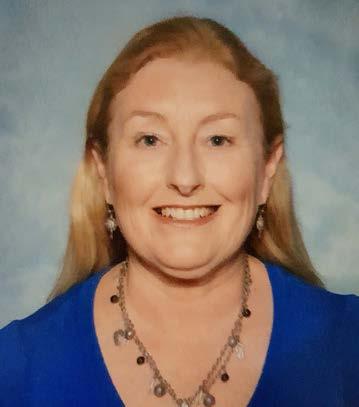
Science has again played an enormous role in our everyday lives as well as some rather unusual events. Space has been in the headlines quite a bit lately, with the launch of the Webb telescope, Artemis 1 launching deep space exploration systems, and the passing close to Earth of an asteroid and, more recently, a comet that hasn’t been observed for 50 000 years. The importance of finding alternative, sustainable energy sources has been a key research area as we move away from the use of fossil fuels. The challenge is to find batteries that can store energy without spontaneously igniting and causing fires! The mining industry has an enormous challenge as they must find the resources needed and mine and refine them without a huge cost that would then be passed on to consumers. Antiviral drugs have
been developed to minimise the effects of COVID viruses, and research continues to find out more about the virus, its ability to mutate and the possible long term effects from the illness. I must make mention of the tiny radioactive capsule that was “lost” in the outback in WA. The caesium-137 capsule, that emits beta and gamma radiation, is used in the mining industry to measure density and flow rates of materials passing through pipes. Interestingly, it was found by a team from the Australian Nuclear Science and Technology Organisation using highly sensitive radiation detection devices. The devices can detect the radiation even with the search vehicle travelling at 70 km/h. Without science, would it still be lost?
Much has happened in the last few months. The Osborne Park office has been sold and we have secured some offices and a storage space in Walters Drive in Osborne Park. This will be our temporary home until Council has time to consider all options and move into fit for purpose premises. Our CEO, John Clarke, has successfully moved everything from Hasler Road and the offices are fully functional. Pamela Getalado has been working as our Marketing and Communications officer and has taken on several other roles in the office. Pamela has fitted into the STAWA team with ease and has already made a marked difference through her support of events, the office and communications.
PAGE 5 VOLUME 69 | MARCH 2023 JOURNAL OF THE SCIENCE TEACHERS’ ASSOCIATION OF WESTERN AUSTRALIA
Annabel Kanakis
science has again played an enormous role in our everyday lives as well as some rather unusual
STAWA looks forward to providing teachers with more events and support for science education excellence in WA. The Synergy Solar Car Challenge kits have already been distributed to many schools throughout the state. The first round of the competition will occur in Perth and across five regional areas in early March.
I encourage all teachers to consider getting their students involved in the Science Talent Search. This is another opportunity for students of all ages to participate in long term projects, investigations and even photography and film making.
We are looking forward to CONSTAWA, our annual conference for all science teachers and technicians, in April. I encourage as many of you to attend as possible as it is a great opportunity to network face-to-face and share ideas with experienced teachers, graduates and education students. The workshops will be many and varied. As it will take place during the school holidays there are no issues with relief which makes it easier for everyone.
STAWA will be hosting CONASTA, the national conference in 2025, and work is already underway to organise this wonderful event. A working party has been formed and we are very lucky to have Professor Lyn Beazley, ex-Chief Scientist and STAWA Patron, as part of the group to advise and to help obtain sponsorship for this extraordinary event.
There will be events and workshops for Psychology and Marine and Maritime Studies later this year, and there are new publications to assist teachers in General Human Biology. There will be other opportunities for professional learning throughout 2023, so check the website and emails for further details.
I would like to thank Allan Knight, from SCSA and a long-time active member of STAWA, for volunteering as the new SCIOS Editor. We thank Siew Yap, our retiring SCIOS Editor, for the outstanding work she did. Without people like Siew and Allan, our members would not enjoy the many services that STAWA offers. I hope that everyone continues their passion of science
education and I wish you all the very best for a successful term. Please consider mentoring a University student for their practicum. They can only learn from models like you, demonstrating knowledge and successful teaching practises that make your students love coming to class.
Annabel Kanakis
VOLUME 69 | MARCH 2023 JOURNAL OF THE SCIENCE TEACHERS’ ASSOCIATION OF WESTERN AUSTRALIA PAGE 6
ChIEf EXECuTIvE’S REpORT

Welcome back to the 2023 school year.
I trust your start was smooth. It has not been the great start that many of you would have hoped. Pressures have included unfinished buildings and all that entails, and a teacher shortage in some schools. I continue to be encouraged by the resilience and capacity of teachers to take disturbances in their stride, while disappointed in the all too frequent, yet often avoidable problems.
CONSTAWA our Primary and Secondary Science Teachers Conference is open for registration. The conference is on Tuesday 18 April, the first week of the Term 1 school holidays. Thanks again to our hosts the Willetton SHS Science department, ably lead by HOLA and STAWA Life member Lance Taylor with the support of his faculty team. It will be a great day starting with our keynote address by Julia Powles. Julia is Associate Professor of Law and Technology at UWA Law School and Director of the UWA Tech & Policy Lab. An expert in privacy, intellectual property, and the law and politics of data, automation and artificial intelligence, Dr Powles currently serves on national advisory committees for responsible AI and robotics. Join us for this provocative opening address titled How to think about the future. Julia will be covering everything from Big Tech regulation to what we should really be suspicious of when it comes to ChatGPT, and it’s not our students. Visit the website to access information and link to registration: https://www.stawa.net/conferences/constawa/.
The Synergy School Solar Challenge, developed in partnership with Synergy, STAWA is pleased to announce the challenge is back in 2023! Events have been underway, an exciting outcome given the last few years of pandemic interruptions. 2023 includes five regional events - Albany, Bunbury, Collie, Geraldton and Kalgoorlie, two large metro events North at St Mark’s Anglican Community School and South at Lumen Christi College, and a Grand Final. The events involve student teams of four. Teams are provided with a new car kit at each event and required to build (engineering challenge) and race their cars on event day. Winners are decided by a tournament style knock out. If you missed out this year and would like to participate keep an eye on your emails and the website (https://www. stawa.net/student-activities/synergy-schools-solarchallenge/) for 2024 expressions of interests invitations.
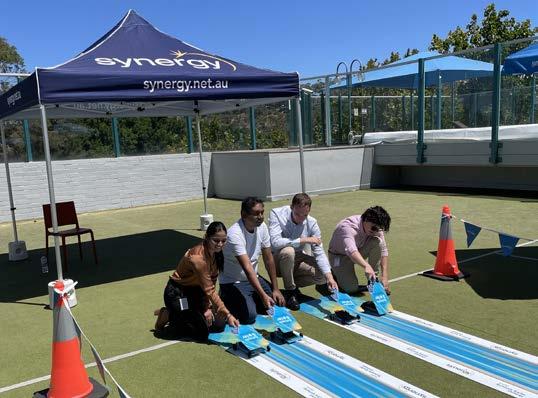
PAGE 7 VOLUME 69 | MARCH 2023 JOURNAL OF THE SCIENCE TEACHERS’ ASSOCIATION OF WESTERN AUSTRALIA
John Clarke
Synergy Schools Solar Challenge – Synergy staff event.
Membership
STAWA has changed from a rolling membership to a fixed anniversary date of 31 January each year. Please contact the office if this change has impacted your renewal. Don’t forget we are dealing with computer automation and all the issues that brings, so please be patient and help us help you correct the issues –contact the office by phone or email.
Member numbers improve our capacity to advocate on science education issues affecting science teachers when talking with Government and Industry. Membership often offers opportunities to develop leadership, curriculum development and presentation skills. STAWA is embarking on several projects this year that require fresh ideas and provide new opportunities for members, including the delivery of online learning to teachers, revision of STAWA resources and the
STAWA pubLICATIONS
Year 11 and 12 ATAR Resources:
development of new resources. Calls for expressions of interest for these tasks will be coming soon if they have not already hit your inbox.
Please encourage your peers, particularly early career teachers to take up STAWA membership. Share your thoughts and ideas to help STAWA grow into the future. The strategic plan is under review. To see the existing plan and new plan once developed visit https://www. stawa.net/about-us/constitution-and-strategic-plan/ Have a safe and enjoyable remainder of the Term.
Your
Chief Executive Officer, John Clarke
• The STAWA Exploring Chemistry, Physics and Human Biology series support the Western Australian Curriculum ATAR Courses.
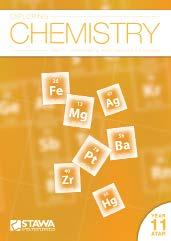

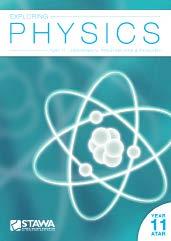
• Year 11 ATAR Psychology Resources for Teachers (digital)
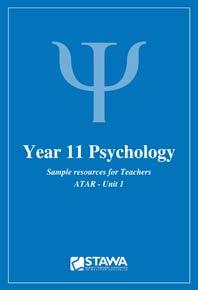
• Psychological Research, Theorists and Studies to Support Psychology ATAR – Units 1 and 2

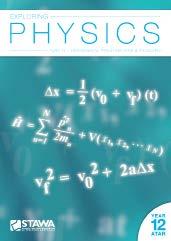
• Human Biology General Course Resources: The STAWA Human Biology General Course Resources will cover both the Year 11 and the Year 12 General Courses.

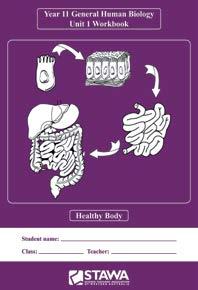
Member Discount: Members receive a 10% discount on all purchases through STAWA.

VOLUME 69 | MARCH 2023 JOURNAL OF THE SCIENCE TEACHERS’ ASSOCIATION OF WESTERN AUSTRALIA PAGE 8
NEW EDITION COMING SOON! NEW EDITIONS COMING SOON!
bEING A JuNIOR buSh SCIENTIST IN yOuR LOCAL buShLAND OR SChOOL GARDEN!
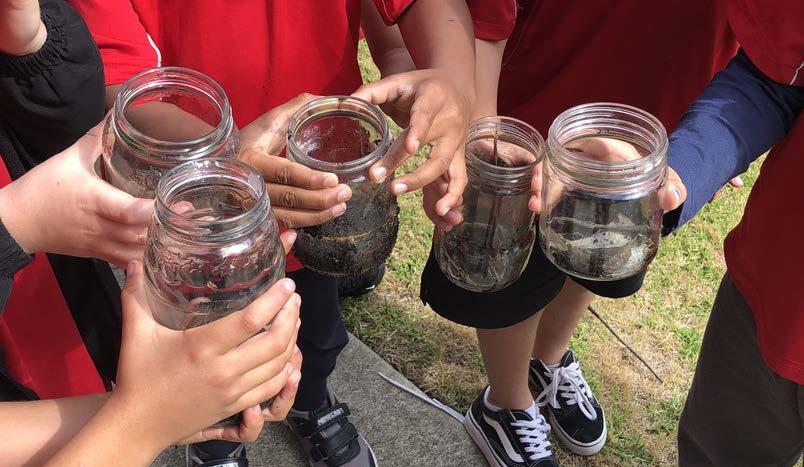 Cathie Donaldson
Cathie Donaldson
I have been the Science Specialist for a number of years at Yale. We received one of the first purpose built Primary Science rooms in the BER grants 15 years ago. I have taught in Canada, the Northern Territory at Jabiluka, Jabiru, Jigalong plus a few city schools. I was seconded to Curtin University with the Centre for Aboriginal Studies in the Bridging Programme then, the Working Cross Culturally Unit for Teaching, Health, and Business and finally, the Bachelor of Education for AIEOs Conversion Course. All positions have been joyful, amazing learning and teaching experiences. I might finish my Bachelor of Social Science in Anthropology and Archaeology one day!
I was fortunate many moons ago to attend a workshop led by Dr Felicity Bradshaw, then based at UWA. She had an amazing repertoire of ideas, photographs, and information about being a junior bush scientist, (Bradshaw 2014)1. Aylesford Reserve (an A Class Reserve) is adjacent to our school, and we have a large
school ground as well as a science veggie patch - all perfect for using some of Dr Bradshaw’s ideas to be a junior bush scientist!
These are just a few of the activities I have developed from Dr Bradshaw’s Be a Bush Scientist resource and they can be used at various year levels by varying complexity and looking for appropriate curriculum links. Our overall focus is on Australian plants, particularly local native plants. The activities presented here are modified for different year levels, follow Noongar seasons, and introduce bush tucker ideas as well as the identification of native plants in the reserve. We also discuss and complete activities to do with photosynthesis, transpiration, and the water cycle, for some year levels - progressively adding depth. The students begin to see the interconnectedness of our environment with more sophistication as they reach Year 6.
PAGE 9 VOLUME 69 | MARCH 2023 JOURNAL OF THE SCIENCE TEACHERS’ ASSOCIATION OF WESTERN AUSTRALIA
urban Nature hunt - This is a Nature Hunt where the (younger) students identify and draw elements from nature. Choose items that suit your school environment. For example:
Nature hunt
Collect 2 different shaped /coloured leaves – how will you record them here?
Make a bark rubbing with a pencil and tissue paper – glue it here
C. Donaldson 2023
Find soil and sand samples – how will you show them here?
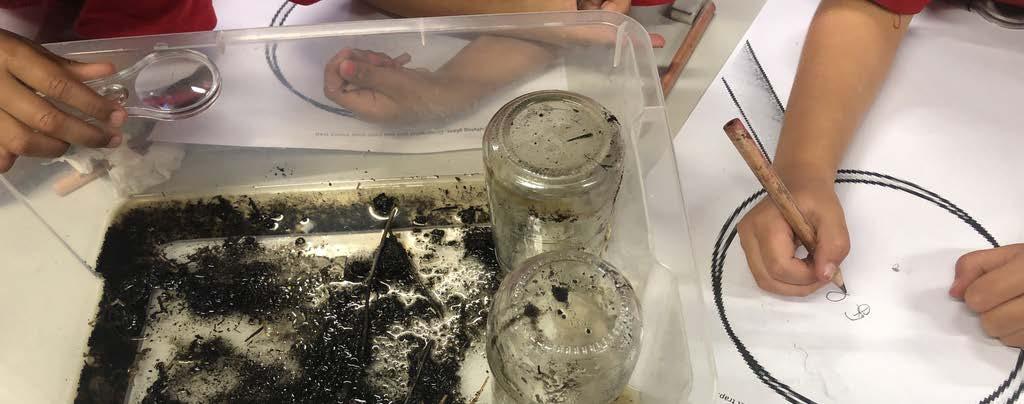
Collect a blade of grass and glue it here
Draw a flower – use a magnifying glass to see the details
Observe an insect and draw it
Sometimes the items can be collected and taped or glued in but at other times a drawn (and labelled?) observation may be the better choice. You could also make this a digital activity though I prefer the hands-on approach to develop observational and recording skills. Magnifying glasses are a useful tool. Older students could have a more complex range of items to collect and observe.
I use Dr Bradshaw’s PowerPoint that is connected to (her) Urban Nature Hunt document which can be used to introduce insect or plant classification depending on the items they will be searching for.
Leaf
litter – what lives in it?
We investigate the invertebrate biodiversity in and under leaf litter. We set up pit traps by digging small holes around the school (not in the reserve), inserting glass jars, and leaving them for a day. Overnight is good especially in warmer weather.
We discuss camouflage (animal and jar), animal health and safety, how weather conditions might affect animals trapped in the jars, possible predation by other animals, student safety while handling glass jars, the potential for encountering stinging/biting invertebrates plus the safe use of digging tools. We recover the jars after a day, fill in the holes, return to the science room and carefully empty the contents into trays.
Correct use of magnifying glasses and digital microscopes is introduced. Students draw what they see in a giant drawing of a magnifying glass. The Science Inquiry Skills (SIS) relevant here are observing and objectively recording their findings with a focus on the animals found in leaf litter.
focus on food chains
We make large paper chains with local examples of a producer (first link), a consumer (second link), and a decomposer (final link) drawn and labelled on each chain. They are hung from the ceiling. We also extend our ideas to food chains associated with food production such as farming and fishing. The idea of a food web is introduced and discussed, but only in passing.
Living things and cells
I introduce the idea of plant and animal cells. Year 5 students make simple microscope slides using plant material – celery stems cut thinly across, and onion skins are excellent to show cells. Two jigsaws of plant and animal cells require students to work together to solve, then we observe similarities and differences.
VOLUME 69 | MARCH 2023 JOURNAL OF THE SCIENCE TEACHERS’ ASSOCIATION OF WESTERN AUSTRALIA PAGE 10
Conservation
Flora, fauna, and the specific language associated with conservation is incorporated whenever relevant. For example – ‘introduced’, ‘feral’, and ‘quarantine controls’ are discussed. Simple poster projects of endangered animals in W.A. are produced, exploring why they are endangered.
Changes in the reserve (or school garden)
Year 6 students observe and record the changes in the reserve throughout the year – mostly to observe plant changes, but any fauna seen are also recorded. The students visit the reserve about 6-8 times during the year for their science class to record their observations of changes in a specific area (quadrat) chosen by them. Each quadrat is 4 metres by 4 metres, and they identify plants and animals on a checklist. Changes in plants such as flowering, fruiting or dropping seeds are noted. By regularly recording in the field, they are developing their skills in scientific drawing – including scale, magnification, and accuracy. Again, digital records can be made but I prefer to develop the hands-on skills!
Restoration of the reserve’s biodiversity
Our school is part of a fantastic planting programme supported by the Gosnells Council and Landcare. The students plant native seedlings with one of the rangers in winter. The ranger discusses the types of native plants and animals in the reserve plus traditional uses of some of the plants. This reserve is a Banksia enclave, and the students love exploring it. They have contributed to making the reserve an extremely healthy and thriving environment over the last 10 years.
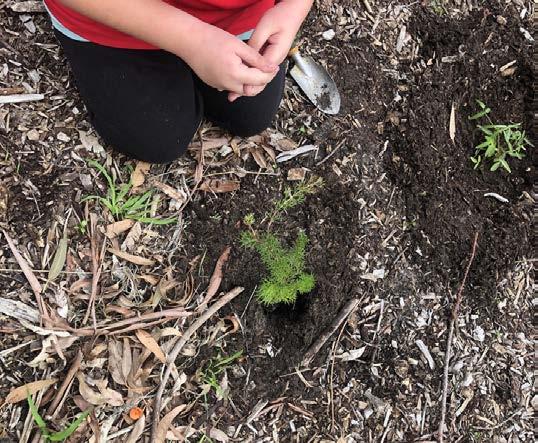
Although some activities link directly with the WA Curriculum: Science, there are also a few incidental activities throughout the school year for all year levels, which makes for enjoyable teaching and ensures the students are fully engaged. I thank Dr Bradshaw for her inspiration and encourage you to ‘adopt and adapt’ this wonderful resource into your science program.
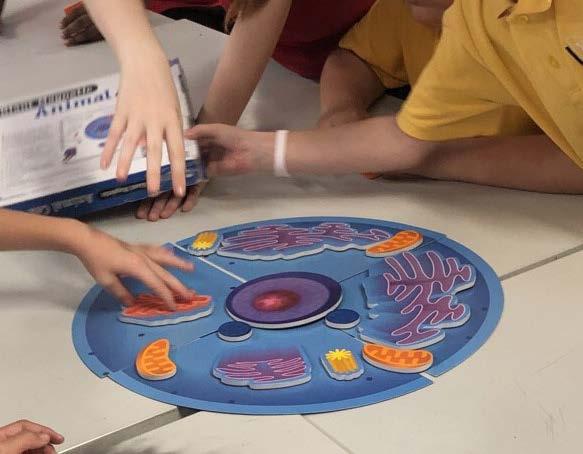
References
1. See also STAWA website under Teachers Resources, SPICE https://www.stawa.net/ resources/spice-resources/
2. Bradshaw, F. 2014, https://www.uwa.edu. au/study/-/media/Faculties/Science/Docs/ Teacher-Guide---Be-a-Bush-Scientist.pdf, retrieved 2023
PAGE 11 VOLUME 69 | MARCH 2023 JOURNAL OF THE SCIENCE TEACHERS’ ASSOCIATION OF WESTERN AUSTRALIA
DO YOU KNOW A SCIENCE TEACHER WHO DESERVES RECOGNITION?
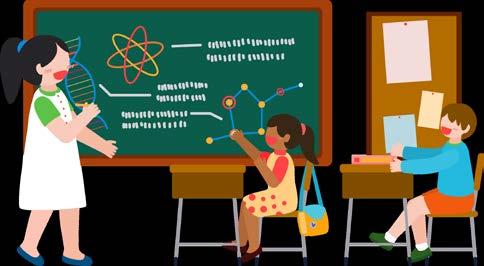
The Science Teachers’ Association of WA invites all West Australian science teachers to consider nominating a STAWA member for either of the following awards.

The de Laeter Medal
Inaugurated in 1998, the de Laeter Medal is one mechanism that formally recognises teachers who have made an outstanding contribution to science teaching in this State. Both primary and secondary teachers are eligible for this award.
The de Laeter Medal will be presented at CONSTAWA on the 18th of April 2023
Click here to find out more and complete the nomination form
The Jeff Cahill Early Career Teacher Award
This award honours and celebrates the work of STAWA member, Jeff Cahill, and his commitment to the science teaching profession as an outstanding secondary science teacher, his volunteer support of STAWA, the delivery of professional learning workshops for teachers and his contributions to STAWA and Pearson publications.
Secondary teachers may self-nominate, or be nominated by another teacher, or a superordinate
The Jeff Cahill Early Career Teacher Award will be presented at CONSTAWA on the 18th of April 2023
Click here to find out more and complete the nomination form.
Nominations for both awards must be received at STAWA by March 31st 2023.
VOLUME 69 | MARCH 2023 JOURNAL OF THE SCIENCE TEACHERS’ ASSOCIATION OF WESTERN AUSTRALIA PAGE 12
REvIvING bOTANy IN ThE CuRRICuLuM uTILISING LOCAL NATIvE buSh SpACES
Biological science involves learning about living things, but how often is it, though, that you take your students outside and study local native plants as a part of your biology lessons? South-west Western Australia is a major biological hotspot and home to 8000 plant species, half of which are not found anywhere else in the world (Hayes, 2014). This is a massive resource for science teachers, and an important tool for educating students on sustainability and caring for the natural world.
This article explores the concept of botanical literacies and how they can be developed in both students and teachers. It is based on my PhD research which was undertaken in early childhood education with 4–8-yearold children and their teachers, but the framework I developed through this research can be replicated across all grades of primary and secondary schools. The overarching aims of this research were threefold. First, to investigate what young children knew about plants in their local bush space—their botanical literacies and what framework and conditions might support the development of these literacies. Second, to investigate the botanical literacies of two early childhood teachers in Western Australia. Third, to investigate the impact of including local Indigenous plant knowledge when supporting the botanical literacies of young children and their teachers.
The research was undertaken in two Western Australian primary schools over the 2020 school year. Both schools had bush spaces on the school grounds and the teachers were already using the bush space with their classes for weekly visits for ‘nature play’. During my fortnightly visits, botanical practices were introduced to the classes including drawing plants, mapping the flowers and plants, making identification cards, using local plant identification books, as well as a visit from a local Aboriginal plant expert to provide information about Indigenous uses for the plants specific to that bush space. The year-long study provided opportunities for the teachers and children to observe the changes through the seasons, and indeed this was a common topic of discussion and interest for both children and teachers.
botanical Literacies
Plant blindness is the inability to recognise not only plants and their names, but also their importance in the ecosystem and an accompanying belief that plants are inferior to humans and animals and are merely a resource to be consumed (Wandersee & Schussler, 2001). An increase in instances of plant blindness could have detrimental effects on efforts in sustainability and the care of our planet (Villarroel & Infante, 2014). Accordingly, the concept of ‘botanical literacies’ was developed by Uno (2009) following his previous research on biological literacies, which involves formulating
PAGE 13 VOLUME 69 | MARCH 2023 JOURNAL OF THE SCIENCE TEACHERS’ ASSOCIATION OF WESTERN AUSTRALIA
Kimberley Beasley
questions about nature as well as making sound ethical decisions around biological issues (Uno & Bybee, 1994). Progressive stages have been proposed as a way of assessing the level of an individual’s botanical literacies, with each hierarchical level addressing an individual’s knowledge of botanical terms and concepts as well as the individual’s excitement and curiosity about botanical topics (Uno, 2009).
Table 1. uno’s Levels of botanical Literacies Literacy Level Knowledge, understanding and behaviours
Nominal level
• Individuals can identify and name terms that relate to botany.
• They may not be able to clearly define or describe the terms and they may have misconceptions about the terms.
• There is no feeling of excitement on botanical topics.
Functional level
• Individuals can use botanical vocabulary and define terms correctly, but responses may be memorised and not deeply understood. This may be due to learning from books, school or television but not being personally involved in hands-on learning.
• There is no feeling of excitement on botanical topics.
generally develop their limit of botanical understandings by the age of nine (Cooper, 2009). With social changes resulting in more parents and grandparents working, and less opportunity for children to gain knowledge from extended family (Brown, 2018), the responsibility for teaching basic scientific knowledge of plants is frequently left to schools (Patrick & Tunnicliffe, 2011). But teachers have also been found to be lacking in plant knowledge and not prioritising the teaching of botany with curriculum demands focusing on other subject areas (Kaasinen, 2019; Patrick & Tunnicliffe, 2011). Likewise international studies indicate that teachers have insufficient levels of botanical literacies to be able to teach relevant botanical information to their students (Kaasinen, 2019). Teachers have also reported not feeling confident to teach botanical studies to their students because of this lack of knowledge, and have suggested that curriculum resources for teachers may improve this confidence (Cooper, 2009).
Structural level
• Individuals can understand botanical concepts and explain these well in their own words and how they are connected. They possess procedural knowledge and skills for undertaking botany themselves.
• Individuals are intrinsically motivated to learn more and formulate questions about nature, which they investigate through botanical inquiry processes. Multidimensional level
• Individuals understand the place of botany within biology as a science, and that plants are vital for life.
• Individuals know the nature and history of plants and can explain the interactions between the botanical world and life on Earth.
• Individuals are curious and formulate questions about nature, which they investigate through scientific inquiry processes involving creative and critical thinking.
• Individuals can make ethically sound decisions regarding botanical and biological issues.
Adapted from Uno (2009)
botanical Literacies in Education
In many cultures, students’ botanical knowledge has been passed down from a family member, such as a parent, grandparent or carer (Jiménez-Balam et al., 2019), but social changes in many families and communities have resulted in less plant knowledge being passed on to children in more recent times (Wyndham, 2010). Unless a desire to learn more about plants arises as an older child or adult, children
In many Indigenous cultures, including Australian Aboriginal and Torres Strait Islander cultures, plant recognition and the knowledge of the uses of native plants has been passed down through generations for the continuance of knowledge about food, medicine, tools and also spiritual significance. Indeed, according to Tsing (2005) the science of botany and the botanical naming of plants was perhaps the first effort at a global knowledge base within the sciences. In respect to Australia’s Indigenous peoples, and considering the Australian Curriculum priority of Aboriginal and Torres Strait Islander Histories and Cultures and Sustainability (Australian Curriculum and Reporting Authority [ACARA], n.d.), it is important to address Indigenous knowledges and names for plants when teaching children. Unfortunately, the introduction of a global naming system has replaced Indigenous knowledges and plant naming practices (Tsing, 2005) such that educating children on the Indigenous names and uses for Australian native plants is a priority if we are to embrace Aboriginal and Torres Strait Islander languages, histories and cultures in our curriculum when teaching with plants in early childhood.
VOLUME 69 | MARCH 2023 JOURNAL OF THE SCIENCE TEACHERS’ ASSOCIATION OF WESTERN AUSTRALIA PAGE 14
The framework for Supporting botanical Literacies
The findings from my research suggest that the ideal framework for developing students’ botanical literacies combines regular time in nature with a botanicallyinterested and passionate adult, who enables curiosity and wonder through hands-on and sensory learning with plants and local Indigenous knowledges. Visiting nature regularly invites young children to notice the subtle changes in nature through the seasons. The regular visits, with the inclusion of Indigenous knowledges and botanical literacy development, supports the findings of Otto and Pensini (2017) who suggested that naturebased education is most effective when it focuses on the promotion of knowledge about flora and fauna as well as real contact with nature. The role of the adult is vital in prompting initial inquiry, providing resources for children’s research and exploration and sharing in the excitement of a new discovery. Figure 1 depicts the framework for supporting botanical literacies developed through this research.
figure 1: framework for Developing botanical Literacies in Early Childhood Education
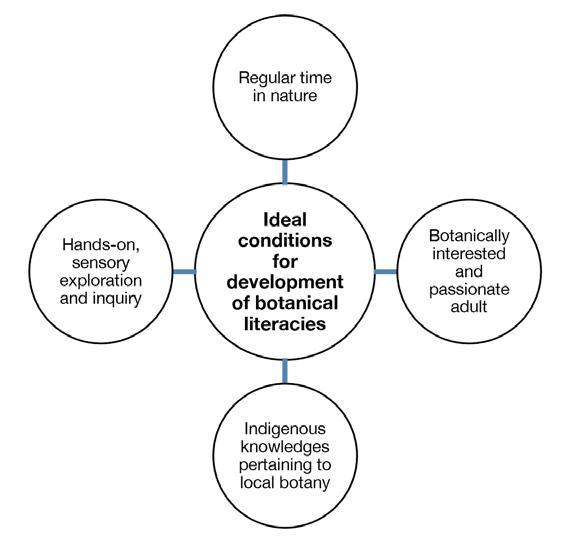
Teaching Strategies for Improving botanical Literacies
The strategies used in this research that supported children’s and teacher’s botanical literacies were as follows:
• Fortnightly visits to the same bush space for 1-2 hours each time.
• Mind-mapping students’ knowledge about plants as a group at the beginning to gauge their understanding and at the end to measure what they have understood.
• Botanical drawings of the flowers and plants in the space.
• Mapping of the plants in the space and when they flower. This mapping was undertaken regularly on clear, transparent laminating sheets to record the changes in the plants and flowers over time. For example, in spring lots of native orchids were mapped that were not visible at other times of the year. This regular mapping is important for attuning the students to the changes of the seasons. This is best correlated to the Indigenous seasons.
• Identifying plants and making photo ‘key rings’ with plant information on them. The key ring is added to each time a new plant is identified and then students can take the key rings with them in the bush to help identify the plants they know.
• Visits from local plant experts and Indigenous Elders to provide knowledge and stories specific to the plants in the bush space.
• For primary and secondary students, I recommend nature journalling regularly in the bush space. Large amounts of information can be collected and recorded over time using this process and it could be used as an assessment piece. A great website with information on nature journalling is www.paperbarkwriter.com
PAGE 15 VOLUME 69 | MARCH 2023 JOURNAL OF THE SCIENCE TEACHERS’ ASSOCIATION OF WESTERN AUSTRALIA
A Suggested year-Long plan for Including botany in the Curriculum
The table below represents a suggested plan for including botany in a biology program over a year. I have included basic information on the local Noongar seasons sourced from the book ‘Noongar Bush Tucker’ (Hansen & Horsfall, 2016). This book is recommended for teachers wanting to undertake teaching about local native plants. The phases of inquiry in the table are based on the ‘Science Inquiry Skills’ from the School Curriculum and Standards Authority (SCSA), which should assist in aligning your teaching of botany with the scope and sequence for the grade/s you are teaching.
figure 2. A Suggested year-Long plan for botany in the Curriculum
Term One plan
bunuru
Second Summer | February & March
The hottest time of the year, Bunuru is a season of little to no rain and hot easterly winds with a cooling sea breeze in the afternoon if you are along the coast. White flowers, especially flowering gums including Jarrah, Marri and Ghost Gums are in full bloom.
fortnightly visit Number phase of Inquiry
1 (Term 1) Questioning and predicting
2 Planning and conducting
Lesson plan
• Eliciting prior knowledge and (3D) mind mapping and drawing/writing
• Introducing the class to maps and making maps.
• Student-led tour of the bush space.
• Group or individual map making. Individual maps could go in the nature journal.
botanical practice and Resources
• Mind map of what students know
• Students drawing and writing
• Bush walk
• Maps of bush/ plants
• Nature journal
3 Planning and conducting
4 Planning and conducting
5 (End of Term 1) Processing and analysing data/ evaluation/ communicating
• Planning where to take the students based on the maps and what questions they have about plants.
• Complete nature journal page.
• Visit to the bush space, exploring for answers to questions and taking photos to identify plants.
• Complete nature journal page.
• Visit to the bush space, exploring, taking photos.
• Flower identification book introduced.
• Review what the students still want to know.
• Bush walk
• List of questions
• Nature journal
• Bush walk
• Photographs taken by the students, they could add notes
• Nature journal
• Bush walk
• Photos
• ID books/ laptops/ iPads
VOLUME 69 | MARCH 2023 JOURNAL OF THE SCIENCE TEACHERS’ ASSOCIATION OF WESTERN AUSTRALIA PAGE 16
Term Two plan
Djeran
Autumn | April & May
Djeran season sees a break in the heat, and a cool change in the season is evident cooler nights and light breezes. This season sees red flowers showing, and Banksias start to bloom now.
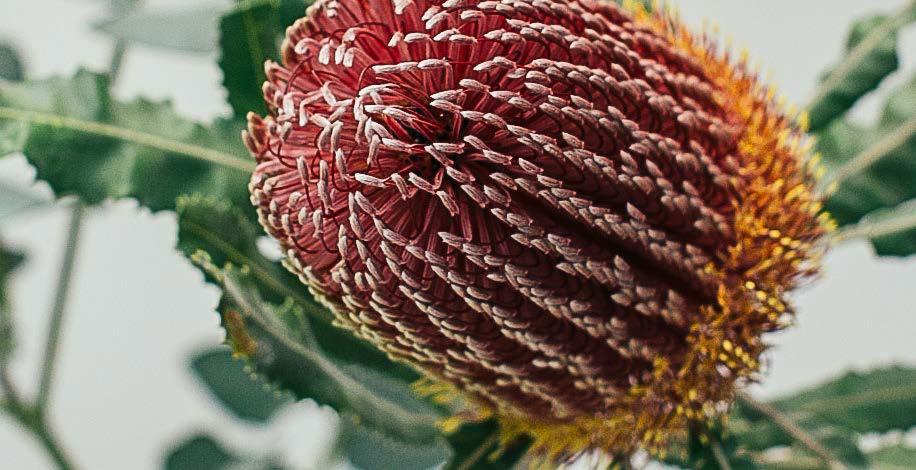
fortnightly
6 (Term 2) Questioning and predicting
7 Processing and analysing data and information
8 Planning and conducting
9 Planning and conducting
10 (End of Term 2) Processing and analysing data and information/ evaluation/ Communicating
Lesson plan
• Eliciting current knowledge after break.
• Walk through the bush. Notice what is different.
• Botanical drawing. This could go in nature journals.
• What questions do the students still have. Brain storm, mind map and prepare questions.
• Invite in an expert.
• Expert visit.
• Review expert knowledge in bush space, add to nature journal.
• Visit to the bush space, exploring for answers to questions and taking photos to ID.
• Could add to nature journal.
• Visit to the bush space, exploring, taking photos.
• Use Flower ID book to identify any unknown plants and flowers. Group conversation reviewing what they have learned this term and what they still want to know.
botanical practice and Resources
• Bush walk
• Botanical drawing in nature journal
• Bush walk
• Questions from students
• Responses from experts
• Add these to nature journal
• Bush walk
• Information from expert
• Nature journal
• Bush walk
• Photographs taken by the students, they could add notes
• Nature journal
• Bush walk
• Photos
• ID books/ laptops/ I-pads
• Nature journal
PAGE 17 VOLUME 69 | MARCH 2023 JOURNAL OF THE SCIENCE TEACHERS’ ASSOCIATION OF WESTERN AUSTRALIA
visit
Number phase of Inquiry
Term Three plan
Makuru
Winter | June & July
The coldest and wettest season of the year. Blue and purple flowers such as Blueberry Lilly (Dianella Revoluta) and the Purple Flags (Patersonia Occidentalis) show towards the end of this cold period.
Djilba
First Spring | August & September
Cold, rainy and windy days, with some sunny days randomly occuring. This is the wildflower season, when you will find native orchids appearing and a variety of colours in the flowers.
fortnightly visit Number phase of Inquiry
11 (Term 3) Questioning and predicting
Lesson plan botanical practice and Resources
• Eliciting current knowledge after break in research.
• Bush walk and noticing what has changed or what is new.
• Mind mapping and drawing/writing.
• Bush walk
• Mind maps
• Drawing/writing
• Nature journal
12 Planning and conducting
13 Planning and conducting
14 Planning and conducting
15 (End of Term 3) Processing and analysing data and information/ evaluation/ communicating
• Create an updated map of the flowers in the space. There will be many new seasonal plants.
• Student-led tour of the bush space.
• Group or individual map-making.
• Planning where to take any new research questions- based on the maps and what the students have seen, What questions do they have about plants?
• Visit to the bush space, exploring for answers to questions and taking photos to ID.
• Visit to the bush space, exploring, taking photos.
• Flower ID book can be used again for unknown plants. Group conversation reviewing what they have learned this term. and what they still want to know.
• Bush walk
• Maps of bush/plants
• Nature journal
• Bush walk
• List of questions
• Nature journal
• Bush walk
• Photographs taken by the students, they could add notes
• Nature journal
• Bush walk
• Photos
• ID books/ laptops/ iPads
• Nature journal
VOLUME 69 | MARCH 2023 JOURNAL OF THE SCIENCE TEACHERS’ ASSOCIATION OF WESTERN AUSTRALIA PAGE 18
Term four plan
Kambarang
Transformational time of the year | October & November
Kamabarang is the wildflower season with many yellow flowers, orchids, kangaroo paws and banksias in bloom. Balgas will flower, especially if they have been burnt in the past year.
birak
First summer | December & January
As the rains begin to ease, the warm weather of Birak starts to take hold with the afternoon sea breeze cooling those close to the ocean. The start of the season sees the flowering of the impressive native Christmas Tree (Nuytsia Floribunda). fortnightly
16 (Term 4)
Questioning and predicting
17 Planning and conducting
18 Planning and conducting
19 Processing and analysing data and information/ evaluation/ communicating
20 (End of Term 4) Communicating
Teacher Reflection Evaluating
Lesson plan
• Eliciting current knowledge after break in research.
• Bush walk and noticing what has changed or what is new.
• Mind mapping and drawing/writing.
• Visit to the bush space, exploring for answers to questions and taking photos to ID.
• Indigenous Elder visit.
• Revising everything learned in bush space. Walk through book sharing new perspectives on plants.
• Add any more new knowledge to nature journal.
• Poster/project, presentation or sharing and presentation of nature journals.
• Teacher reflects on own botanical knowledge.
• Bush walk
• Mind maps
• Drawing/writing
• Nature journal
• Bush walk
• Photographs taken by the students (they could add notes)
• Nature journal
• Elder/expert visit
• Bush walk
• Nature journal
• Bush walk
• Nature journal
• Preparing presentation for next session
• Some form of poster/presentation or sharing of nature journals
• Notes and reflection on year and plan for next year
PAGE 19 VOLUME 69 | MARCH 2023 JOURNAL OF THE SCIENCE TEACHERS’ ASSOCIATION OF WESTERN AUSTRALIA
visit
phase
Number
of Inquiry
botanical practice and Resources
An Overview of the findings of this Research on botanical Literacies
The use of multiple modes of communication throughout this process enabled students to communicate their knowledge and understanding clearly through the use of multiliteracies (Hesterman, 2013) as students were not solely reliant on verbal or written communications. Students were able to demonstrate their learning through map making, drawing, photographs, conversations and mind maps, allowing teachers to gain a full picture of understanding of the students about the plants in the bush space. The students’ botanical literacies developed profoundly over the year, with most children initially naming less than four plants (and only a few children could name a native plant), but by the end of the study some could recognise and name over thirty native plants. Interestingly, the development of the teachers’ botanical literacies around native plants also dramatically improved.
Previous research has suggested that teachers often hold little plant knowledge and have low confidence in teaching about plants (Skarstein & Skarstein, 2020). My study confirmed that such teachers can be brought to a place of feeling confident and knowledgeable enough in their botanical literacies to enable them to lead students in botanical inquiry. They can also be equipped to mentor other teachers and deepen these botanical practices throughout their respective schools to become embedded school-wide practice.
The inclusion of Indigenous knowledges from a Traditional Owner in this study demonstrated that such knowledge can strongly support children to develop the highest level of botanical literacies. The authentic stories and hands-on engaging pedagogies of the Traditional Owner awakened the children to the interconnectedness of humans and nature. This study also showed that it was beneficial for the children to have a strong foundational knowledge of plants to begin with, so that the Indigenous knowledges became relevant and meaningful.
Conclusion
In light of climate change, and the UN Sustainable Development Goals (United Nations, 2015), we all have a responsibility to care for the land we live on; the land that supports our everyday lives. To care for something requires knowledge about that thing, and in supporting children’s knowledge about specific plants in their local spaces and how those plants change and provide us with what we need for life as part of an interconnected eco-system, this research has demonstrated a way for teachers to connect themselves and their students more deeply to nature. I would encourage all teachers to take their students outside and find a local area of native bush. I believe this will encourage students (and teachers) to improve their plant knowledge, grow their respect for our beautiful biodiverse environment, find meaningful ways to incorporate Indigenous knowledge, and to aspire to care for this land in sustainable ways for the future.
About the Author
Kimberley Beasley is an Associate Lecturer in the College of Science, Health, Engineering and Education at Murdoch University. As part of her research interests, she developed a framework for teaching botany for all teachers including those who do not have experience in plant knowledge. The framework uses inquiry, regular visits to bush, Indigenous knowledge, longterm documentation and following natural cycles. She worked with early childhood students in developing the framework but it is suitable with all grades.
VOLUME 69 | MARCH 2023 JOURNAL OF THE SCIENCE TEACHERS’ ASSOCIATION OF WESTERN AUSTRALIA PAGE 20
References
1. Amprazis, A., Papadopoulou, P., & Malandrakis, G. (2019). Plant blindness and children’s recognition of plants as living things: a research in the primary schools context. Journal of Biological Education, 1-16. https://doi.org/10.1080/00219266.2019.1667 406
2. Hayes, L. (2014). Biodiversity hotspot in WA explained. Australian Geographic https:// www.australiangeographic.com.au/
3. Brown, J. M. (2018). Grandparents and Grandchildren Negotiating Nature Together ProQuest Dissertations Publishing].
4. Cooper, C. L. (2009). Integrating schoolyard flora into the first grade science curriculum (Vol. Dissertation/ Thesis). ProQuest
5. Hansen, V., & Horsfall, J. (2016). Noongar bush medicine: Medicinal plants of the south-west of Western Australia. UWA Publishing.
6. Hesterman, S. (2013). Early childhood designs for multiliteracies learning. The Australian journal of language and literacy, 36(3), 158-168.
7. Jiménez-Balam, D., Alcalá, L., & Salgado, D. (2019). Maya children’s medicinal plant knowledge: Initiative and agency in their learning process. Learning, Culture and Social Interaction, 22, 100333. https://doi. org/10.1016/j.lcsi.2019.100333
8. Kaasinen, A. (2019). Plant species recognition skills in Finnish students and teachers. Education Sciences, 9(2), 85. https://doi. org/10.3390/educsci9020085
9. Patrick, P., & Tunnicliffe, S. D. (2011). What plants and animals do early childhood and primary students’ name? Where do they see them? Journal of Science Education and Technology, 20(5), 630-642. https://doi. org/10.1007/s10956-011-9290-7
10. Skarstein, T. H., & Skarstein, F. (2020). Curious children and knowledgeable adults – early childhood student-teachers’
species identification skills and their views on the importance of species knowledge. International journal of science education, 42(2), 310-328. https://doi.org/10 .1080/09500693.2019.1710782
11. United Nations. (2015). Sustainable Development Goals. United Nations. Retrieved 6th May from https://www.un.org/ sustainabledevelopment/
12. Uno, G. E., & Bybee, R. W. (1994). Understanding the dimensions of biological literacy. BioScience, 44(8), 553-557. https:// doi.org/10.2307/1312283
13. Villarroel, J. D., & Infante, G. (2014). Early understanding of the concept of living things: an examination of young children’s drawings of plant life. Journal of Biological Education, 48(3), 119-126. https://doi.org/10.1080/00219 266.2013.837406
14. Wyndham, F. S. (2010). Environments of learning: Rarámuri children’s plant knowledge and experience of schooling, family, and landscapes in the Sierra Tarahumara, Mexico. Human Ecology, 38(1), 87-99. https://doi. org/10.1007/s10745-009-9287-5
PAGE 21 VOLUME 69 | MARCH 2023 JOURNAL OF THE SCIENCE TEACHERS’ ASSOCIATION OF WESTERN AUSTRALIA
Teaching about water?
The Waterwise Schools Program offers free, curriculum-linked incursions to all schools within the Perth metropolitan area. Students learn about the water cycle, Perth’s water supply, water in Aboriginal culture, and how we can all be waterwise.
In 2022 we delivered our program to over 33,000 students. Don’t miss out this year! Book your incursions now at watercorporation.com.au/education
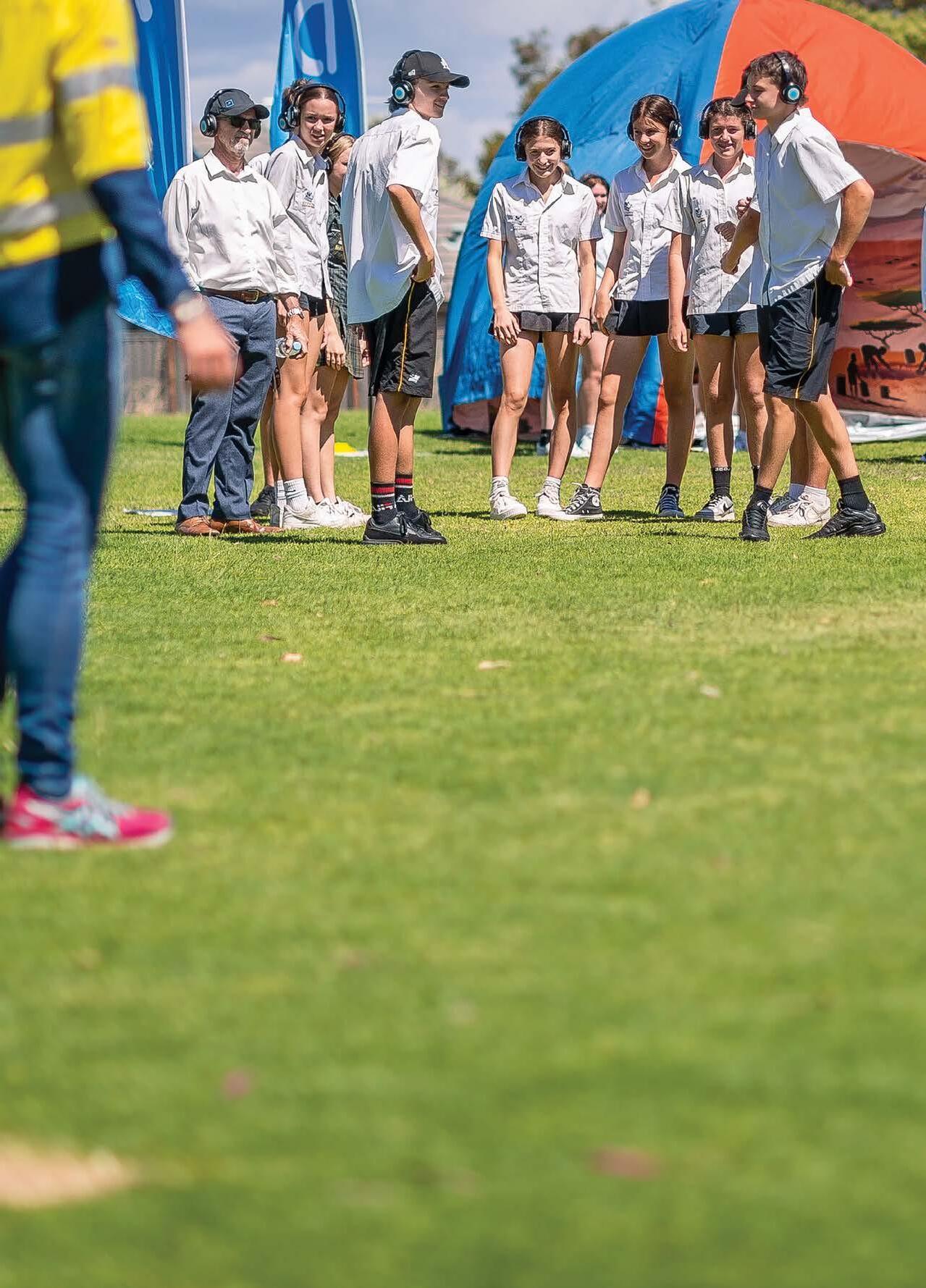
Waterwise Experience
Year Groups: 7 - 10
This interactive, multisensory incursion engages students using silent disco technology and inspires them to explore water sustainability. They’re led through narratives that empower them to act on preserving and valuing our planet’s finite resources.
Water in Aboriginal Culture
Year Groups: 2 - 7
Students learn about the strong connection Aboriginal people have with water and why. The 60,000-year-old water management and conservation practices taught in this incursion inspire students to learn about the difference they can make to our water future.
Water Supply or Conservation
Year Groups: PP - 7
Students learn about Perth’s drinking water sources, treatment processes and catchment protection.
During the incursions, students will identify ways they can conserve and reduce water use.
Teaching in regional WA? Visit our website for online teaching resources and additional lesson plans.
STAWA is seeking someone interested in the position of Coordinator for STAWA's Science Talent Search (STS) competition.

This is a voluntary position and involves advertising, coordinating the competition entries, managing the judging process, and organising the presentation of prizes.

The STS Coordinator will be supported by STAWA office staff and in the past has been assisted by a small group of volunteers, with the intention for this to continue.
If you are passionate about engaging students in science, this could be the role for you!
For more information, contact John Clarke at STAWA (john@stawa.net)
PAGE 23 VOLUME 69 | MARCH 2023 JOURNAL OF THE SCIENCE TEACHERS’ ASSOCIATION OF WESTERN AUSTRALIA
fIRST LEGO LEAGuE
Larissa Waghorn
In this day of ‘immediate everything’, how do you capture the imagination of your students and keep them engaged, motivated and learning skills that will help them in this ever-changing world? Skills like resilience, teamwork, coding, persistence, creativity, patience, and respect.
Seven years ago, I discovered a program that covers all of these and is great fun! It is called the First LEGO
League (FLL). Why does it capture a kid’s imagination? It involves two things that they love – LEGO and robots!
Now I can already hear you saying, “I don’t know anything about robots or coding, so this is not for me.” You don’t need to know - the idea of this program is to develop the students as autonomous learners and work things out for themselves. You are there to supervise and help manage personalities. Our students regularly come to me to say, “I don’t know how to do this” and my thought is usually “Neither do I” - but we work it out together and if all else fails we Google it. The proof of this is that one of our teams was awarded a trophy for being ‘Autonomous Learners’ – learning in spite of the coaches!
So, what is First LEGO League (FLL) all about? FLL is an international program that started in 1989 in the USA and came to Australia in 2006. My students have been participating since 2017. Each year there is a theme and students look at different issues relating to that theme. They then design their own solutions to address one of the issues that is relevant to them.
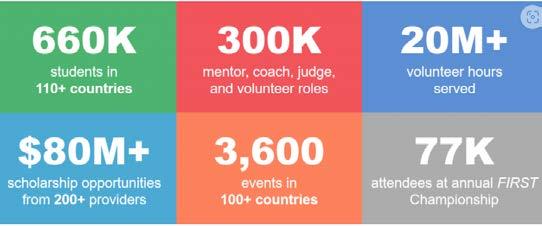

VOLUME 69 | MARCH 2023 JOURNAL OF THE SCIENCE TEACHERS’ ASSOCIATION OF WESTERN AUSTRALIA PAGE 24
There are a number of levels to the League, and each requires participation in different ways. I teach in a primary school, so we participate in the Explore (Years 2-4) and Challenge (Years 4-8) divisions, but there is also a Robotics Competition division (14–18 year-old students) and a Discover division (K-Year 1).
Our junior squad participates in FLL Explore and is for our students in Years 3 and 4. We operate on Tuesday afternoons in Terms 2 and 3. Students work in teams of 6 – 8. Each group requires either a Lego WeDo or Prime robot and a FLL kit. Each group has one moving component that is controlled by their robot. This component is the same for each group, but the movements and sounds it makes are chosen by the team and therefore the programming will be different. This is the start of the differences between each team’s final creation.
FLL provides an Engineering Workbook that sets out what will be covered during each session. Each week the students are given a challenge to complete that relates to the topic. This challenge will ask them to think about a component and design and make something out of Lego that will be added to their solution.
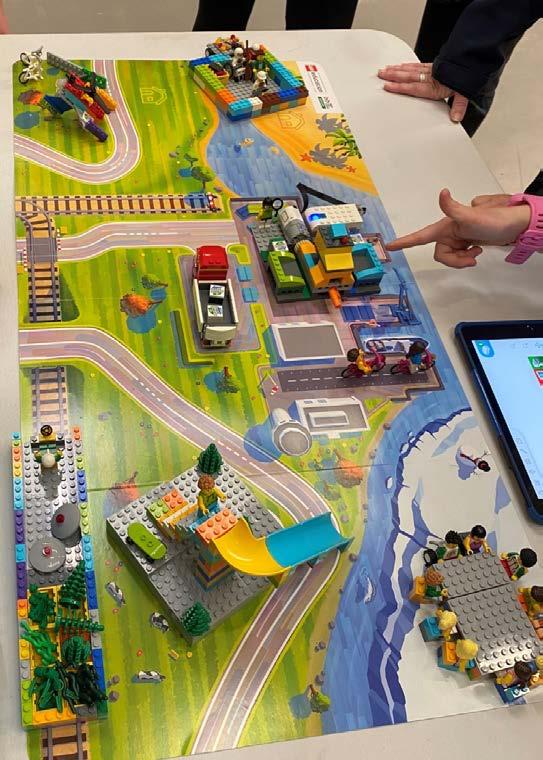
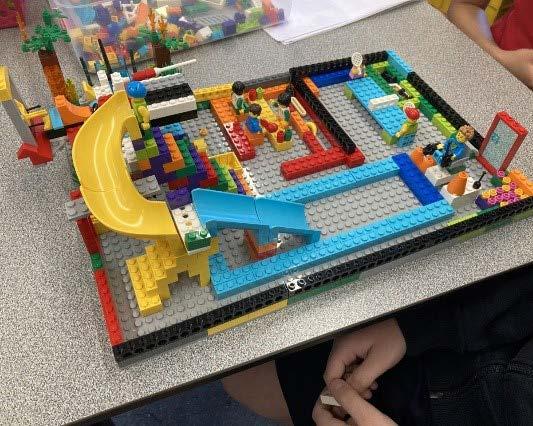
At the end of the semester, we hold an exhibition at school and invite family, friends, the school board, our staff, and other special guests. The students then showcase what they have created and explain their creations with reasons for their choices.
Our senior squad participates in FLL Challenge and is for our students in Years 5 and 6. We operate on Thursday afternoons in Terms 3 and 4. Students work in two teams with a maximum of 10 students per team. We usually start the season with more students in each team and with some students dropping out, end up below the maximum.
Each group requires either a Lego EV3 or Prime robot. A FLL kit is also required, but one kit can be shared by two teams. This competition is quite different to Explore. When the competition goes live in August, the complete details and kits are sent out. The kit includes

PAGE 25 VOLUME 69 | MARCH 2023 JOURNAL OF THE SCIENCE TEACHERS’ ASSOCIATION OF WESTERN AUSTRALIA
all the LEGO needed to create the challenges which are then placed on a large mat on a table. These are made in exactly the same way for all teams across the world. Students then program their robot to complete as many of these challenges as possible in a two-anda-half-minute round. This requires LOTS of patience, resilience, and persistence but the excitement when it works is amazing!
The ‘robotic’ component is only one part of this competition. Teams must also complete an Innovation Project. For this the students identify a problem relating to the theme and design a solution. They are encouraged to research the problem and their solution, including speaking to experts about it. On the competition day they present their solution to a panel of judges in any manner they choose. The competitions are held in late November/early December in Perth and there are also regional competitions.
At the competition, each team will have three rounds on the table with the robots. Each round lasts for two and a half minutes during which they complete as many challenges as they can. There are only allowed to be two people at a time at the table, but you can tag in and out. The round that reaches the highest score is the one that is counted as the final score.
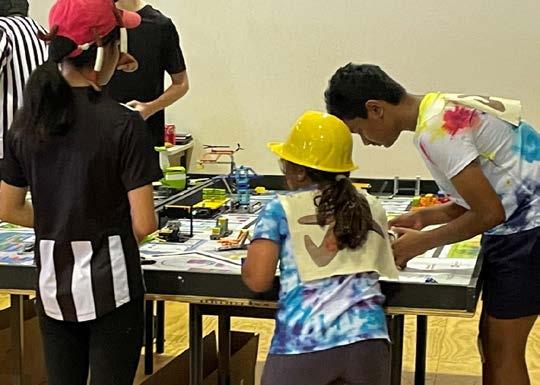
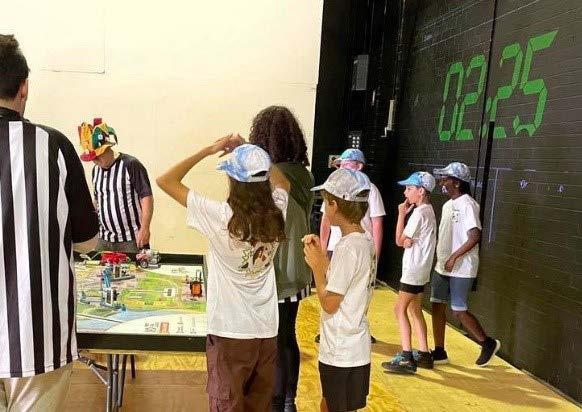
The other component is a half hour judging session. During this session the judges are looking at three areas:
• the Innovation Project presentation
• the robot design choices and coding
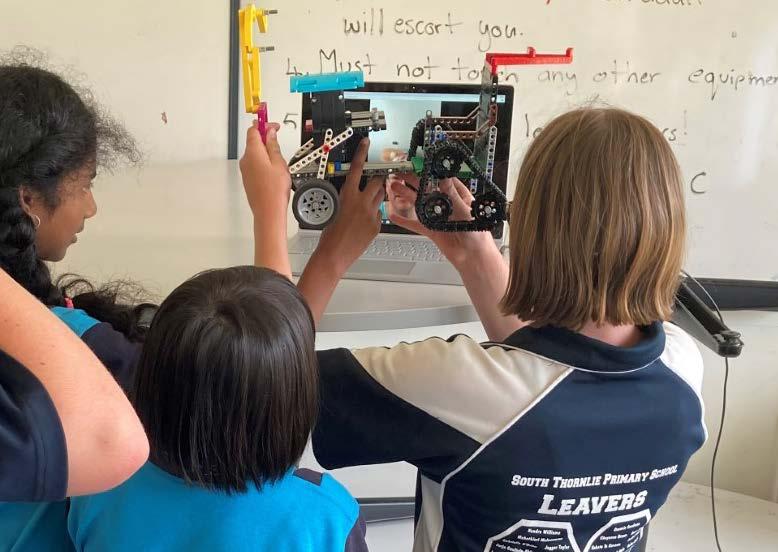
• teamwork, especially relating to the core values
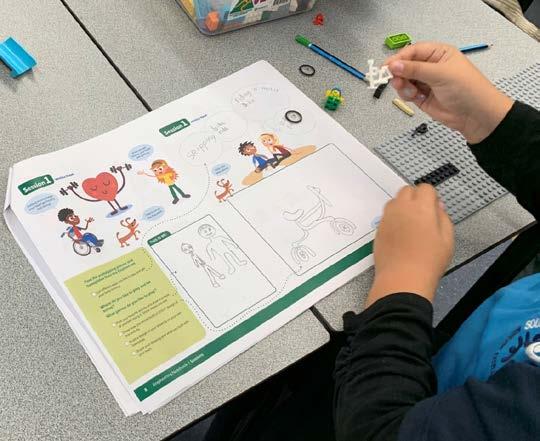
VOLUME 69 | MARCH 2023 JOURNAL OF THE SCIENCE TEACHERS’ ASSOCIATION OF WESTERN AUSTRALIA PAGE 26
Core Values
1. Discovery – exploring new skills and ideas 2. Inclusion – respecting others and embracing differences 3. Innovation – using creativity and persistence 4. Teamwork 5. Impact – improving our world 6. Fun – enjoying and celebrating what we do!
The
are:
The competition day is fantastic. There is lots of energy, colour and fun. The judges, who are all volunteers, are great as they interact with the students, and regularly come up with ideas to help them for their next round. There are teams from primary schools and high schools and from both the public and private sectors.
Most of the teams wear costumes so they can identify as a team and show their personalities. On the day there are over 20 trophies, LEGO ones of course, that are awarded for all components of the competition, including their Teamwork and Core Values. Over the years we have received a number of trophies for different aspects and these take pride of place in our front office.
Obviously, there are costs involved in this program. Our initial costs were covered by a Google grant that covered our first EV3 and first year’s entry. The WeDo robots were purchased using the Science Grant. Previously, we have applied for the “Sponsorship Grants for Student Science Engagement and International Competitions” to cover registration, costumes, expenses, and pizza rewards each year for both groups.
Unfortunately, the government has decided not to continue with this grant so we will be approaching
companies and our local politicians for funding this year. Over the seven years that we have been entering, the school has only paid for one EV3 robot and the registration costs for one year. This year (2023) our school will be covering relief for two teachers so that we can go to the midweek competition rather than the weekend competition. Some schools ask parents to pay a small amount to help cover costs.
FLL does have a grant available for first time teams. https://firstaustralia.org/get-involved/grantapplications/

The kit price includes all the necessary Lego, lesson plans, engineering workbooks for students and for the Challenge division, includes the competition entry.
So, hopefully I have inspired you rather than scared you off! FLL has been the most rewarding program that I have ever had my students involved in and I hope to see you at a competition soon.
PAGE 27 VOLUME 69 | MARCH 2023 JOURNAL OF THE SCIENCE TEACHERS’ ASSOCIATION OF WESTERN AUSTRALIA
Current Competition Comparison
Pricing may change in the future
Junior Robotics - fLL Explore Item Cost (excl GST)
Lego WeDo robot per team $340 each $1360 (Set of 5)
FLL kit per team $50 (previous) $75 (2023)
Postage $45 (approx.)
Plastic boxes - large 20 litre $25 (set of 4 incl GST)
Plastic boxes - small 5 litre $4.75 each (incl GST)
• Teams of 4-6 students (last year we had 8 teams, this year we have 5)
• We have Years 3 & 4
• One robot per team
• One FLL Explore kit per team
• Not a competition
• Students present creations at an exhibition where we invite parents, school board, local paper
• We run previous year’s kit to save money and because the new kit doesn’t come out in time
• We run in Terms 2 & 3
• Everything gets packed into plastic boxes each week; each team has a large and small one
• Students build up different parts each week and eventually have a component that moves and is controlled by the ‘robot’
• Each team designs their own solution to the real-life problem, created with LEGO
Senior Robotics - fLL Challenge Item Cost (excl GST)
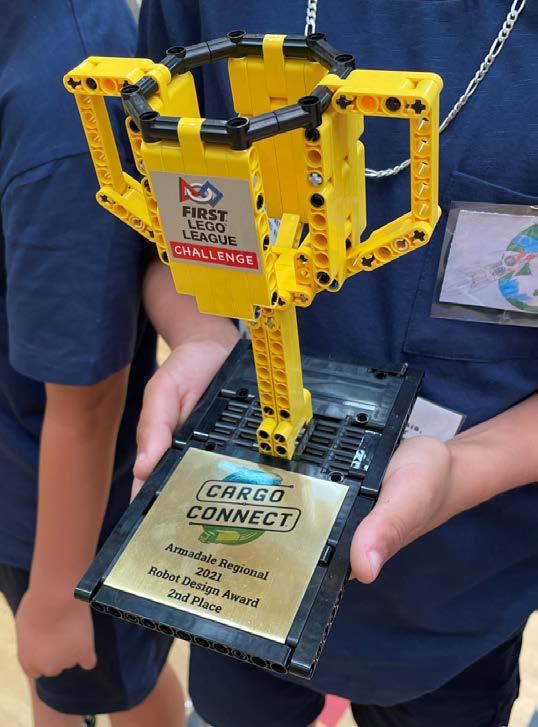
Lego EV3 or Prime (1 or 2) $630 each
FLL kit $500 for 1 team $600 for 2 teams sharing kit
Postage $45 (approx.)
• Teams of up to 10 students (we have 2 teams each year, frequently start with more than 20 students but some drop out)
• We have Years 5 & 6
• One robot per team
• One FLL Challenge kit covers two teams
• Competition held against other schools in Nov/Dec
• Choice of whole day competitions, both midweek / weekend
• Competition kit sent out August 1
• We run in Terms 3 & 4
• Needs a table (can just be a board on top of tables). It is better if the table can be left set up for duration of competition
• A series of missions where teams design a robot that they program to complete as many missions as possible within 2½ minute rounds
• Each team develops a presentation of their solution to the real-life problem for the judges at the competition
About the Author
Larissa has been teaching in primary schools for over 20 years and about 10 years ago as a Science Specialist. She was the Technology Lead Teacher for three years to help upskill staff and ensure her school had suitable resources for their students. She has worked with SCATS in the development of a digital tracker that covers Science Inquiry Skills throughout primary school curriculum and one of her career highlights has been receiving the Coach Award for the 2022 FLL Competition.
VOLUME 69 | MARCH 2023 JOURNAL OF THE SCIENCE TEACHERS’ ASSOCIATION OF WESTERN AUSTRALIA PAGE 28
pRIMARy SCIENCE COMMITTEE COffEE CATCh-upS
first SOR Coffee Catch-up – done!
On February 22nd we met at Lo Quay and enjoyed lots of networking and some great coffee. It was fabulous to meet first time primary science specialists (just 4 weeks on the job!) and catch up with some long-time experienced teachers. Everyone is keen to meet again, and we are starting to organise some open labs for teachers to come and see how others are organising their science spaces.
NOR Coffee Catch-up
Primary science north of the river coffee catch-up was held on March 9th at Hillarys Boat Harbour. What a lively bunch of primary science teachers – so much to talk about and share. Not to mention the chocolate and deep-fried churros!
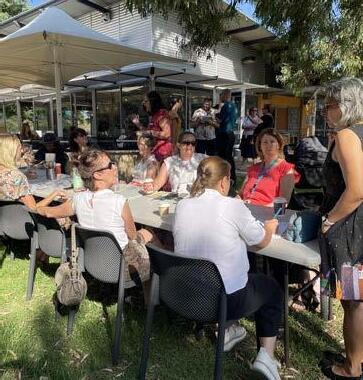
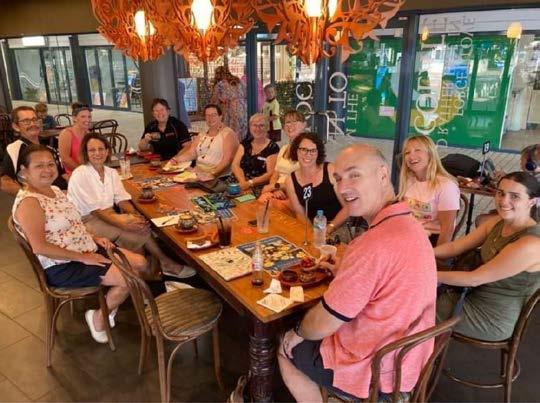
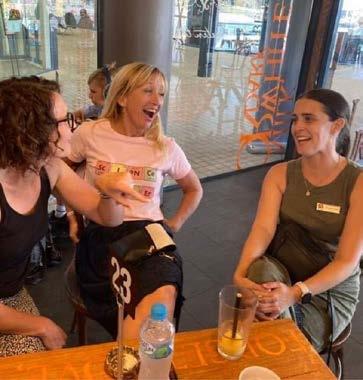
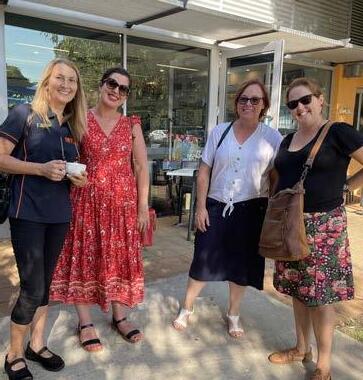
Scho
If you have been teaching primary science for 5 years or less – or even if you a to begin this rewarding career – AND you have not attended CONSTAWA befo you to apply for this scholarship
The value of the scholarship will be personal science resources of your choice $200 plus 1 year’s membership to STAWA (current value $155) Both current non-members of STAWA are eligible to apply
Mady Colquhoun
WHAT DO YOU NEED TO DO?
Let us know why you think attending CONSTAWA will be of benefit to your science teaching (½ to 1 page).
Ask your line manager or principal to support your application and attendance CONSTAWA 2023, including confirming your role as an early career science this year (1/2 page).
Make sure you include your personal details.
Email your application as one document (1 – 2 pages total) to john@stawa.net
March 31st. Use this title on the email – Application for Primary Science
WHAT'S THE CATCH?
Why are we having Coffee catch-ups? Primary science teachers usually work in isolation within their school. Often they are in the science role because they love science BUT they may not have a lot of science education from their more generalist training. In the early years especially, teachers need to network and be able to ask questions of more experienced teachers and attend PL relevant to their role – and STAWA provides one of the few opportunities to offer this (see you at CONSTAWA!).
None really - except that you need to be registered to attend CONSTAWA as the scholarship will be awarded to the recipient at CONSTAWA.
NOT SURE ABOUT CONSTAWA?
Check out the STAWA website when registrations open mid-February
The Primary Committee hopes to have a catch-up somewhere on ‘either side of the great divide’ each term so keep an eye out in your emails if you are a member, the STAWA Facebook page or other primary science social media.
COME ON - WHAT ARE YOU WAITING FOR?
SUBMIT YOUR APPLICATION BY FRIDAY, 31 MARC
PAGE 29 VOLUME 69 | MARCH 2023 JOURNAL OF THE SCIENCE TEACHERS’ ASSOCIATION OF WESTERN AUSTRALIA
s – then
1 2 3 4
C O M M I T T E E
STAWA Early Career Primary Science Scholarship
Are you an early career Primary Science Specialist? If yes – then read on!
If you have been teaching primary science for 5 years or less – or even if you are just about to begin this rewarding career – AND you have not attended CONSTAWA before, we invite you to apply for this scholarship
The value of the scholarship will be personal science resources of your choice to the value of $200 plus 1 year’s membership to STAWA (current value $155) Both current members and non-members of STAWA are eligible to apply
WHAT DO YOU NEED TO DO?
Let us know why you think attending CONSTAWA will be of benefit to your science teaching (½ to 1 page).
Ask your line manager or principal to support your application and attendance at CONSTAWA 2023, including confirming your role as an early career science specialist for this year (1/2 page).
Make sure you include your personal details.
Email your application as one document (1 – 2 pages total) to john@stawa.net by Friday March 31st. Use this title on the email – Application for Primary Science Scholarship.
WHAT'S THE CATCH?
None really - except that you need to be registered to attend CONSTAWA as the scholarship will be awarded to the recipient at CONSTAWA.
NOT SURE ABOUT CONSTAWA?
Check out the STAWA website when registrations open mid-February
COME ON - WHAT ARE YOU WAITING FOR?
SUBMIT YOUR APPLICATION BY FRIDAY, 31 MARCH 2023

PRIMARY SCIENCE
1
3
2.
4.
SAfETy IN ThE pRIMARy SCIENCE LAbORATORy
Teaching science in a primary science laboratory is amazing but can also be a bit daunting when you are new to the role with close to 400 students per week coming through your lab. Students vary from tiny to big, quiet to noisy, confident to shy, excited to not-so excited. There is so much to consider when you are trying to keep students engaged as well as safe.
The most important aspect of teaching science in your laboratory is Safety – with a capital S!
The chances are you have had NO safety training in general science nor for specifically teaching in a laboratory. Right?
Well, you are not alone – primary teachers often have to work out what to do, how to do it and most importantly - how NOT to do it, without any assistance. No wonderful laboratory technicians to advise us or even help sort out, set up or clean up equipment. No other science teacher to talk things over with or gain from their experience.
So – how can we make our science class safe – every time?
first ‘rule’ (not really a rule but it just sounds good) Just because you see it on the internet it does not mean it is safe or even appropriate for primary students
– or even relevant to the WA curriculum. If you are searching on the ‘net’ – go to trusted Australian sources not just random ideas and activities posted by unknown people. Is it Australian? Other countries may have different safety standards, resources, and curriculum requirements. If it involves blowing up something, then there is a good chance that it may not be safe in a primary classroom. Look at the list of safety requirements – make a judgement call based on your experience, resources, and your students. We do not need to do spectacular things – science is amazing on its own.
Second ‘rule’
If these were your children/family members/friend’s children, would you be considering doing this activity with its associated risk level? Would you be happy for another teacher to do this with your children? If so –how do you consider your safety approach to the activity? Is it safe as a hands-on for all students, better as a demonstration or should you substitute a video? If you need to start Googling to see if the materials/ chemicals are safe for primary students or if there is any special safety equipment needed, the chances are it is NOT appropriate for primary school.
Third ‘rule’
Try everything first! When tackling an activity for the first time, assemble all the equipment and materials and do
PAGE 31 VOLUME 69 | MARCH 2023 JOURNAL OF THE SCIENCE TEACHERS’ ASSOCIATION OF WESTERN AUSTRALIA
Mady Colquhoun
it yourself before using it in the classroom. This way you can experience how successful it may or may not be as a teaching/learning tool as well as identify the potential safety risks. As you do each activity set up a simple recording system (see below) to identify the risks so you can talk to the students about them (maybe not all the risks but some of them – after all, identifying safety hazards is part of the curriculum). It is your job to mitigate the rest of the safety hazards.
Once you have completed the activity, demonstration, or investigation then it is a simple matter to go back to the safety sheet you have already filled in and add extra things you have noted or did not think about or even suggestions for next time to improve safety. A couple of minutes is all it takes – file it away for next time – or throw it in the metaphorical bin if you consider it is not safe enough to repeat or not worth accepting the safety issues for the learning experience. Once you have this system up and running you will have a wealth of information to remind you every time you are planning to do the same activity.
NOTE - in secondary schools this is done for all activities in a much more formal way.
how and what to record
The outline in Figure 1 is a simple and easy to use template for recording safety related matters for science activities (adapted from PRISCI Pin Up 2013 issue 4, Safety with Primary Science investigations). The full copy is available on the STAWA website for all teachers under the ‘resources’ tab (https://www.stawa. net/resources/teachers-tool-kit/). On the website there are also a few examples of practical activities with the safety template filled out to give an idea of what might be considered.
final ‘rule’
If there is potential for something to go wrong – it will! (Murphy’s Law). Even the most simple and straightforward activity can toss up some tricky /unsafe situations in the hands of eager, well-meaning but inexperienced primary students.
In the words of Oscar Wilde (paraphrased):
EXPECT THE UNEXPECTED!
As a primary science specialist, you certainly will not be disappointed!
About the Author
Mady taught primary science as a specialist for 10 years learning much over those years but would have been grateful if there had been someone to mentor her from day 1. She has volunteered with STAWA since 2010 in various roles and is currently the Chair of the STAWA Primary Science Committee, Convenor for CONSTAWA, a member of the STAWA Council and a SCIOS editorial committee member. She is motivated to undertake this because she is passionate about making primary science a safe and wonderful experience so teachers can be supported in this role and produce more scientists in the future.
VOLUME 69 | MARCH 2023 JOURNAL OF THE SCIENCE TEACHERS’ ASSOCIATION OF WESTERN AUSTRALIA PAGE 32
figure 1: Template for recording safety related matters for science activities
Teacher – what does the teacher need to be aware of and what must be discussed with the students?
Students - what should the students identify and consider? Is there anything you need to draw their attention to? Can they identify risks themselves?
Location – any special considerations? Is the location approapriate for the activity?
Materials and equipment – is it age appropriate? What safety issues need to be considered?
PAGE 33 VOLUME 69 | MARCH 2023 JOURNAL OF THE SCIENCE TEACHERS’ ASSOCIATION OF WESTERN AUSTRALIA
Write your investigation title or practical activity here Date it.
ChARGING INTO A bATTERy-pOWERED fuTuRE
Western Australia is leading the way in the supply chain for lithium-ion batteries, which are revolutionising mobility and power generation. Therefore, an understanding of battery science is more relevant than ever before.
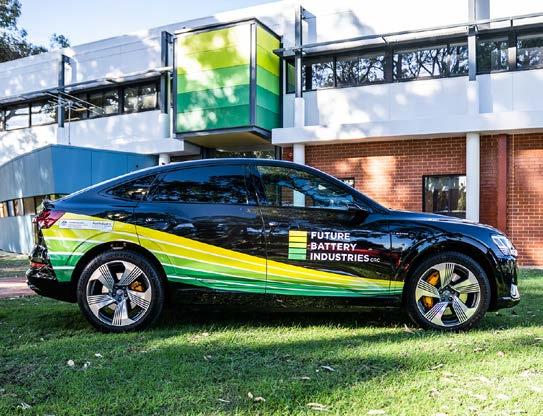
This article explores WA’s dominance in the lithium-ion battery material supply chain, describes contemporary battery science in EVs and storage systems, and describes the rapidly emerging jobs around battery materials, production and deployment.
Electric vehicles
When students think of batteries, many will think of a Battery Electric Vehicle (BEV) such as a Tesla or the powerful Audi e-tron BEV in Figure 1. BEVs have become commercially feasible due to the advances in science such as the maximizing of “energy density”. A typical lithium-ion battery with a Nickel-ManganeseCobalt oxide (NMC) cathode might have an energy density of 200 Wh/kg, around six times greater than a traditional lead-acid battery. The gains in gravimetric energy density, along with a 10 times reduction in manufacturing cost per kWh over the past decade, have increased the cost effectiveness of BEVs.
There are many types of BEV battery configurations. Some Teslas, for example, have a 355 volt battery. The voltage comes from having 96 “cells”, each nominally 3.7 volts, connected in series. One car might have as many as 3000 individual cells, such as the “21700” cylindrical cells, each 21 mm diameter and 70 mm high. The sets of cells are arranged in parallel “bricks” to add the desired energy storage. Longer range BEV versions have an additional set of bricks connected in parallel.
home Storage
More than one third of Western Australian homes have rooftop photovoltaic (PV) panels connected to the grid making large amounts of electricity available to the grid
VOLUME 69 | MARCH 2023 JOURNAL OF THE SCIENCE TEACHERS’ ASSOCIATION OF WESTERN AUSTRALIA PAGE 34
Dr Rodney Thiele
Figure 1: The FBICRC’s Audi e-tron fully electric vehicle has a 95 kWh battery (© 2021 Future Battery Industries Cooperative Research Centre. Used with permission.)
during daylight hours. This means that utility generators need to provide little energy in the middle of the day but still ramp up generation load quickly in the early evenings when solar and wind outputs reduce and household use increases.
Households can sell their electricity to the grid, but the value of that contribution decreases as more and more PV units have been installed. That is causing some households to also install a home battery, to store their PV output and make it available in the evening or during a blackout.
A home battery is a small form of a Battery Energy Storage System (BESS). A typical home BESS may have a capacity of 10 to 15 kWh. At around $1000/ kWh the economics of this are still marginal, so the main drivers to instal home BESS are likely to arise from environmental concerns or a desire for self-sufficiency.

Larger batteries
“Community” batteries, like this Western Power trial battery in Yokine (see Figure 2), are being installed across WA. They may store around 500 kWh, the equivalent of 40 home batteries.
The Synergy “Big Battery” is being built at Kwinana. This will deliver a maximum power output of 100 MW
over two hours. At 200 MWh (i.e., 200,000 kWh) it is the equivalent of around 16,000 home batteries. It will soak up some of the daytime excess energy from PVs and wind turbines and despatch it in the evenings. Community and big batteries also help address energy equity by supporting those unable to afford rooftop PV. The world’s first “Big Battery” was built at Hornsdale, South Australia, in 2017. Its battery components cost around $250/kWh which is a fraction of current home battery costs.
Across WA there are many BESS systems proposed or under construction, including for mine-sites and communities seeking to reduce reliance on fossil fuels. Some are expected to exceed 1 GWh capacity.
What’s in a Cell?
There are many types of lithium-ion cells currently in use, and many more in concept or research and development stages. Popular today are lithium ferrophosphate (LFP) cells. These have preferred safety ratings but lower energy density – and therefore shorter BEV range – compared with NMC cells. Hence, LFP tend to be favoured for smaller EVs and for BESS, while NMC cells are favoured for larger cars or in countries where range anxiety may be more prevalent.
PAGE 35 VOLUME 69 | MARCH 2023 JOURNAL OF THE SCIENCE TEACHERS’ ASSOCIATION OF WESTERN AUSTRALIA
Figure 2: This community battery at Yokine, Western Australia, has two 232 kWh lithium-ion batteries (© 2022 Future Battery Industries Cooperative Research Centre. Used with permission)
By mass, lithium makes up only around 2-3% of a cell. It is called a lithium-ion cell as it is the lithium (Li+) ions (only) that migrate electric charge through the cell, back and forth between the mixed transition metal oxide (e.g., LiNi0.8Mn0.1Co0.1O2) “cathode” and the graphite “anode”. Separating these are a semipermeable polymer membrane and throughout the cell are electrolytes and binders.
WA’s unique Advantages
Western Australia is one of the few jurisdictions in the world that has abundances of most of the materials needed to support the lithium-ion battery revolution. This is leading to a modern gold rush, as companies explore and develop mines and processing plants. Lithium, nickel, manganese and cobalt are four of our most important battery materials, especially for lithiumion batteries with NMC cathodes.
Lithium
Western Australia produces about 50% of the world’s lithium supply for batteries. Our lithium comes from an alumino silicate ore called spodumene (LiAlSi2O6). The Greenbushes mine in WA is one of the best spodumene deposits in the world at around 2.5% lithium oxide. At Greenbushes, the ore is concentrated to around 6% lithium oxide via a combination of dense media separation and flotation methods. Until 2022, most of WA’s spodumene concentrate was shipped to China, Japan or Korea.
In June 2022 the Kwinana Lithium Plant started converting spodumene concentrate into battery-grade lithium hydroxide monohydrate (LiOH·H20). Another two conversion plants are being built in WA presently, the Kemerton Lithium Plant and the Covalent Lithium Plant (Kwinana). When fully operational around late 2024 they will collectively convert around 1.2 million tonnes per annum (tpa) of spodumene ore to make 200,000 tpa of battery grade lithium hydroxide monohydrate.
Nickel
Most WA nickel goes into making steel. In late 2021 BHP Nickel West opened its new nickel sulfate plant in Kwinana. When fully operational, it will produce
100,000 tpa of battery grade (around 99.98% pure) nickel sulfate hexahydrate (NiSO4·6H20). This is a further exciting initiative as WA develops its downstream processing and more jobs are created in a variety of areas including chemistry, process engineering and electronic instrumentation control.
Manganese
Most WA manganese comes from the mineral pyrolusite (essentially MnO2) in the East Pilbara. From there it is shipped overseas for processing. Manganese is a critical ingredient in steel production, which consumes around 90% of global manganese supply. WA does not presently make battery grade manganese compounds.
Cobalt
Most WA cobalt comes from operations in the Eastern Goldfields and Ravensthorpe regions, normally as a co-product in nickel mines. Australia is the world’s third biggest producer of cobalt, and the country’s role will continue to grow as manufacturers look to ensure ethical cobalt sources and avoid production from the Democratic Republic of Congo which has been associated with poor labour and environmental practices.
A future Workforce
At present, most of WA’s battery-related jobs are in mining and concentrating of battery minerals. Additionally, there are also roles in integration and services, such as installing EV chargers, installing BESS at commercial and domestic scales, and in sales and servicing EV and e-rideables.
However, with the shift from exporting ore to concentrating and refining, and the manufacture of batteries and deploying EVs and BESS, the number of jobs is growing rapidly. The Future Battery Industries Cooperative Research Centre’s (FBICRC) Future Charge Report (2021) identified that around 20,000 new STEM jobs will be created in the Australian battery industry by 2030 across the following roles:
• plant operators
• installers
• electricians
VOLUME 69 | MARCH 2023 JOURNAL OF THE SCIENCE TEACHERS’ ASSOCIATION OF WESTERN AUSTRALIA PAGE 36
• technologists
• laboratory assistants and technicians.
A further 8,000 university-educated professionals will be needed, including in these fields:
• material science
• industrial metallurgy
• electrochemistry
• chemical engineering
• electrical and electronic engineering.
Teachers of science can play a vital role in helping grow our battery-related workforce by raising awareness of the latest trends in battery science and informing students about the exciting future employment opportunities in the clean-tech sector. This will benefit students pursing STEM related studies. It will also contribute to developing a pipeline of candidates for the workforce of the future.
About the Author
Dr Rodney Thiele
Education and Training Manager
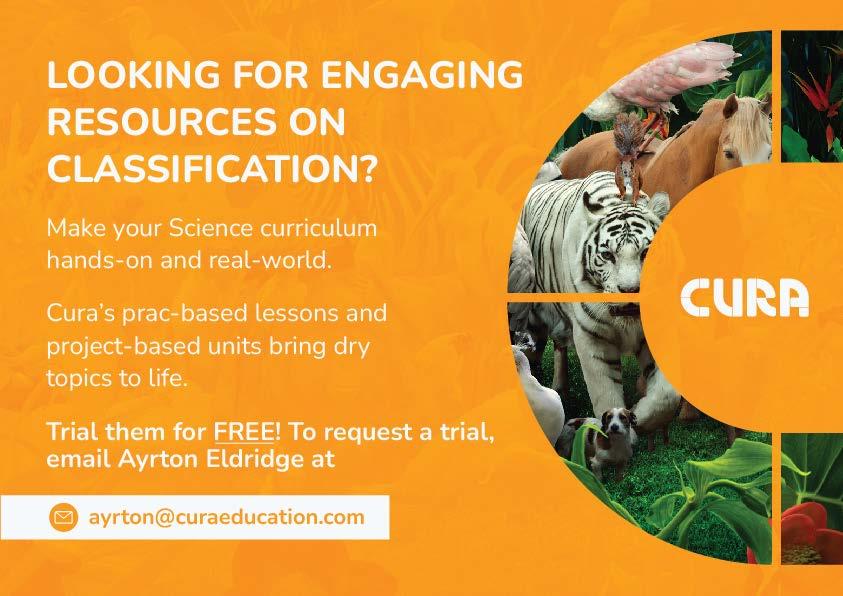
Future Battery Industries Cooperative Research Centre
References
1. Future Battery Industries Cooperative Research Centre. (2021). Future Charge: Building Australia’s Battery Industries. June 2021
https://www.curaeducation.com/science
WhAT CAN ThE ChIEf EXAMINER TEACh uS?
Lyndon Smith
Each year in March after the ATAR examinations are complete and the candidates have their results, the School Curriculum and Standards Authority publishes a report on each of the examinations on its website. As part of the report the Chief Examiner offers advice gleaned from reviewing the examination scripts.
These comments are applicable to any teacher and any student of an ATAR course so might be relevant to Years 10, 11 and 12 studies in that subject. Over the next few issues of SCIOS we will include a brief summary of some of the past few years’ advice for a number of ATAR courses. In this issue we provide a summary for Chemistry.
Chemistry
The Examination – preparation
Learn the symbols of chemistry. The Years 11 and 12 syllabuses include a list of 56 molecules and ions. Because they are in the syllabus, the examiners assume you know them.
Begin your exam revision early (research into how our brains work show that, for most people, regular ongoing revision and study is a better way to learn than is cramming just before an exam). Give yourself your own timed exams using past examination questions. Test yourself until you can get 100% repeatedly on
your own difficult exams. Use these tests to find out what you don’t know and practise these areas. Where possible include past papers in your study.
Equations are the language of chemistry. Write them often and include them in explanations even if they are not specifically asked for. Writing them is quicker than using words.
You should know commonly used reactions –
• acid + base,
• acid + active metal,
• acid + carbonate,
• ammonium salt + a strong base
Be aware that the examinable content of the syllabus includes knowledge, understandings and skills.
Learn to think critically and apply knowledge of chemistry rather than just rote learning.
Know how to generate, read, and apply data from graphs and tables.
Practise writing clear, concise, and coherent explanations and justifications; incorporating illustrative, labelled diagrams that are clear and relevant. You have limited space and time in which to answer.
VOLUME 69 | MARCH 2023 JOURNAL OF THE SCIENCE TEACHERS’ ASSOCIATION OF WESTERN AUSTRALIA PAGE 38
Practise writing equations providing the appropriate formulae and state symbols for only those species that are taking part in the reaction unless otherwise directed - “ionic equations”.
Understand the difference between “state”, “explain” and “describe”. State means to express the main points in a topic. Explain means to relate cause and effect; provide why and/or how. Describe means to give a written or spoken report of how something is done or of what something is like.
Learn strategies for answering multiple-choice questions, such as eliminating answers to narrow down the options.
The Examination
Plan your answer. Avoid writing down points in random order as they come to you. Pack as much information into the answer as possible, but avoid irrelevant information. The number and accuracy of relevant concepts is more important than the number of words. Writing using headings is a good way to ensure you have answered all aspects of the question.
Some students have a prepared answer in mind and deliver it whether the question asks for it or not. This technique might earn you no marks at all and use up a lot of time. Answer questions with specific reference to what the question demands rather than as a generalisation or implication. Candidates are not necessarily awarded any marks for correct chemistry unless it pertains specifically to the question asked.
Do not leave a question blank. Write a part answer. It might earn you part marks.
Do not personify chemical species or processes. For example, H atoms does not “want” to lose an electron. Answer using the terms requested in the question e.g., if asked for a name, give the name, if asked for a symbol/formula, give the symbol/formula.
Be conversant with the terms used in the syllabus, e.g., chemical test, data, evidence.
Be familiar with, and how to clearly express, the expected observations and inferences that can be made for the reactions indicated in the syllabus. For example: All solutions are clear; some are colourless and some exhibit a colour. Referring to clear solution is redundant and is not the same as referring to a colourless solution. Copper sulfate solution is blue, while sodium sulfate solution is colourless; both are clear because they are solutions.
Use the appropriate chemical terminology when answering questions.
Be specific in your answers, and avoid adding information just to fill up the space allocated for an answer.
Many candidates appeared to have given up if they were unable to complete part (a). They should be encouraged to press on with subsequent parts of a question even if they have had difficulty with earlier parts.
Candidates need to be reminded that ‘observations’ such as ‘lead iodide formed’ or ‘tin metal formed’ are not observations but inferences.
Don’t spend time writing answers that digress from the actual question.
Respond to the specific question being asked. For example, if a question needs an explanation, then a few words is not going to allow you to do this.
Marks are not awarded for re–stating information provided in the questions nor for vague references and full marks are not awarded when failing to demonstrate how an answer was obtained.
Be concise and efficient in language.
PAGE 39 VOLUME 69 | MARCH 2023 JOURNAL OF THE SCIENCE TEACHERS’ ASSOCIATION OF WESTERN AUSTRALIA
You should describe observations in as much detail as possible – e.g., a fruity/sweet smell should be described as just that, rather than simply a “strong smell”. A detailed observation is evidence of understanding of a process, and more general descriptions of observations cannot be rewarded.
Writing “no visible observation” is a nonsense statement. Clearly when an orange solution has been added to colourless solution and the final solution is orange, that is an observation.
Do not use lazy expressions like “NaOH” rather than “sodium hydroxide solution” or “NaOH(aq)”. Strictly speaking, NaOH refers to the compound which is a solid at normal temperature and pressure.
For observations describe the before, during and after reaction observations.
Graphing skills – curved lines should be smooth, straight lines should be straight.
Should your graph use “line of best fit” or “join the points”?
Equations
Write correct formulae and correctly state symbols.
The colour of the ion will determine the colour of the solid.
Remember “amount of oxygen” is measured in “moles” not volume or mass.
Where chemical equations were given, they were very often not balanced, or were molecular rather than ionic. Candidates must be encouraged to take care in writing chemical equations throughout the examination. The examiners expect that equations to be balanced.
VOLUME 69 | MARCH 2023 JOURNAL OF THE SCIENCE TEACHERS’ ASSOCIATION OF WESTERN AUSTRALIA PAGE 40
SCIENCE TALENT SEARCh
Julie Weber
In 2022, students from 26 schools from around WA participated into the 65th Science Talent Search competition, including schools from the Mid-West, Goldfields, Pilbara and South West. Students from participating schools worked on projects as part of their science lessons, extension classes, science clubs or at home, with the best entries being selected for submission into the competition. 225 entries from 398 students were submitted for judging into one of the three entry categories. The presentation ceremony was held on Monday 24 October at Scitech.
I would like to congratulate all students who participated in competition in 2022 and their teachers and parents for supporting and encouraging them. A special thank you goes to the judges of the competition. STAWA looks forward to your participation again this year. Information about this year’s competition available on the STAWA website.
What is Science Talent Search?
The Science Teachers’ Association of Western Australia has been promoting creative project work in science through the Science Talent Search competition since 1958. The Science Talent Search is a wonderful opportunity for students from Kindergarten to Year 12 to develop their interests in science through a competition with several different categories to suit a wide variety of abilities and interests. The Science Talent Search also provides students with an opportunity to expand their
scientific literacy, by showing interest and understanding in the world around them and engaging in discussions about science.
Many schools include the Science Talent Search into their curriculum, using their students’ final products as part of their assessment program. The best work is then entered for final judging. All students who participate, not just those who are entered for final judging, are eligible to receive participation certificates.
The range of categories and the flexibility in the choice of topics provides an ideal basis for:
• learning about science
• involving students in first-hand science experiences
• implementing inquiry based and studentcentred learning
• catering for individual learning styles
• catering to a wide range of abilities and interests
• facilitating open-ended investigations and projects
• assessing Science Inquiry Skills and Science
Science Talent Search Entry Categories
Science investigation - An investigation is an attempt to find, in a scientific way, the answer to an original question.
PAGE 41 VOLUME 69 | MARCH 2023 JOURNAL OF THE SCIENCE TEACHERS’ ASSOCIATION OF WESTERN AUSTRALIA
Understanding
Engineering - Engineering is the application of Science, Mathematics and Technology to invent new products or modify existing products that benefit society.
Scientific Communication - Communication is important in the scientific community to inform the public and other scientists about science ideas. In the Science Talent Search Scientific Communication category entries can take the form of:
• Science Poster (Years K-2 only)
• Science Video (Years K-12)
• Science Photography (Years K-12)
Science Talent Search Key dates – 2023
Date Event
Monday 6
March – Friday
25 August
Monday 7 August – Friday
25 August
Monday 7 August – Friday
25 August
Friday 25 August
School registration Online at STAWA website https://www.stawa.net/
Student Entry Submission
Student registration will occur at the time of entry submission. Information about the process is available on the STAWA website https://www.stawa. net/ and will be sent to school coordinators.
Registration of Science Talent Search judges Online at STAWA website https://www.stawa.net/
Entries submitted for Science Talent Search State Judging
Science Investigation (Years 3-12), Engineering (K12) and Science Communication – Video (K-12) Online submission due by 5.00 pm
56th Science Talent Search
year 7-8 Engineering – 1st place winners
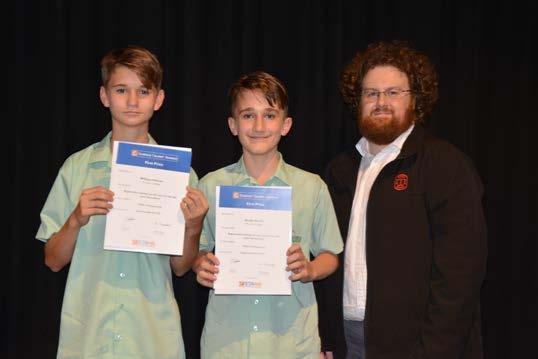
Regenerative fishing rod and reel: Let the fish catch themselves!
William Holmes and Brodie Smith
In the making of the prototype Regenerative Fishing Rod, ways to use sustainable energy instead of nonrenewable energy were investigated. Conventional electric fishing rods are charged from the electricity stored in the boat battery or from plugging into a power outlet with electricity from the grid. In these cases, the electricity is generated from power stations.
Friday 25 August
Entries submitted for Science Talent Search State Judging
Science Investigation (K-2), Science Communication – Poster (K-2) and Science Communication –Photography (K-12)
Due at the STAWA Office by 3.00 pm
The Regenerative Fishing Rod, uses the fish’s kinetic energy to spin the reel to generate renewable electricity. It also does not need any cords, so you have the freedom to move around the boat when the fish does.
Friday 8 September –
Monday 18
September
Monday 26 September
– Friday 29 September
Science Talent Search State Judging – Round 1 Round 1 Judging online
Science Talent Search State Judging – Round 2 TBC
October STS presentation Ceremony 4.30 – 7.30 pm at Scitech
Monday 23
October and November Return of Entries
K-2 Posters, K-2 Science Investigations and K-12 Photography entries not collected at presentation ceremony returned to schools.
Designing an electric fishing rod that uses renewable energy was chosen as both students have a passion for fishing and wanted to catch fish easily and sustainably. This invention would also be useful as living in a remote area means access to grid electricity to charge devices is limited.
VOLUME 69 | MARCH 2023 JOURNAL OF THE SCIENCE TEACHERS’ ASSOCIATION OF WESTERN AUSTRALIA PAGE 42
William Holmes and Brodie Smith (St Luke’s College – Karratha) and Jarryd Sommers (Rowe Scientific Pty Ltd)
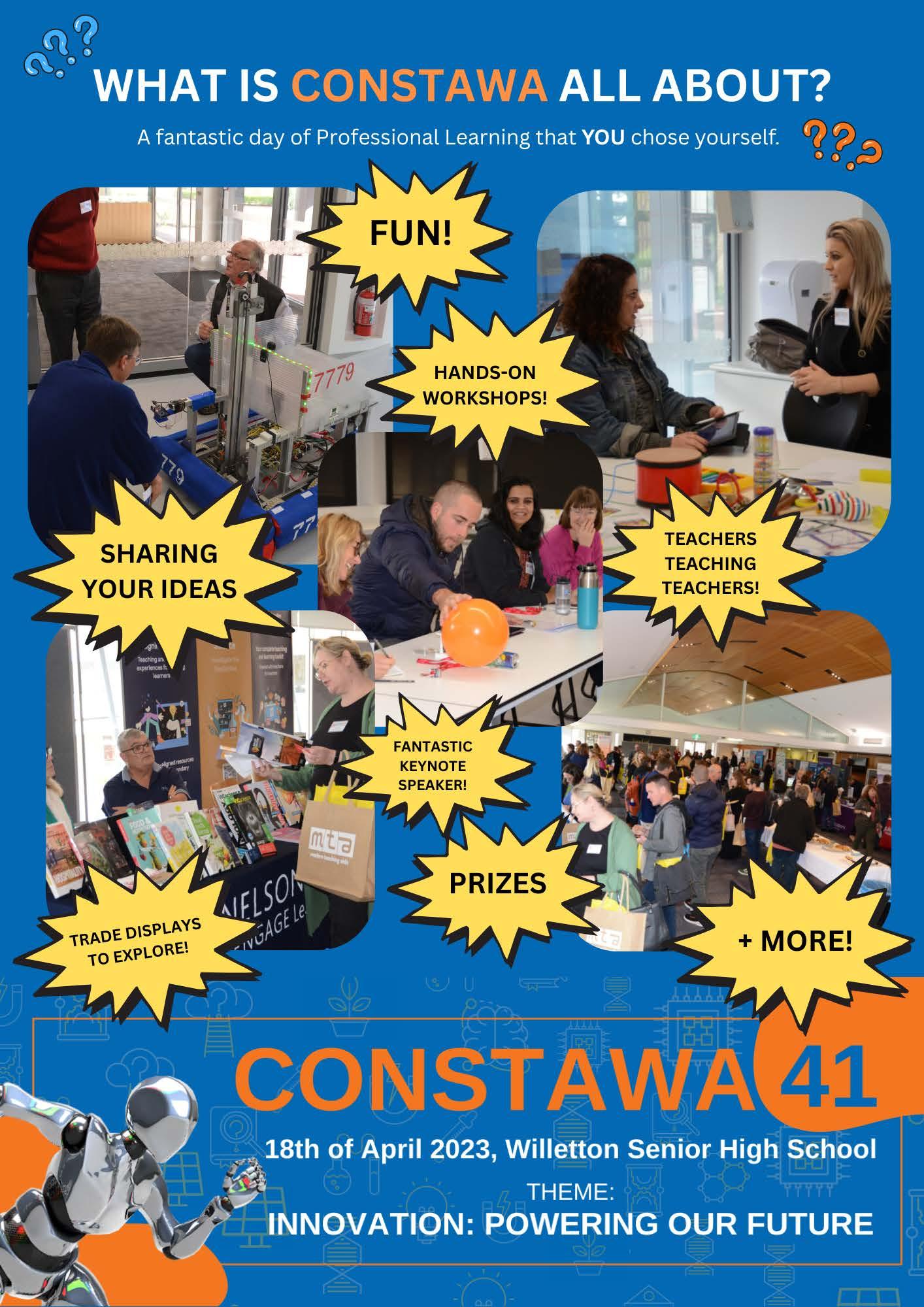
CLICK hERE TO REGISTER!
bOOK TITLE: Eyes Wide Open. Integrated, holistic and flexible science ideas and activities for young children.
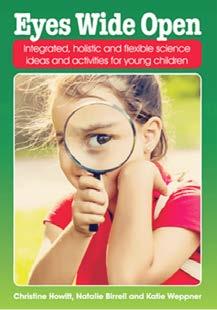
AuThORS: Christine Howitt, Natalie Birrell and Katie Weppner
Eyes Wide Open is a fantastic resource to integrate Early Years Science lessons within the early childhood setting. The book focuses on four modules that are of high interest to children of this age group.
1. Superheros
2. There’s a zoo in my room
3. Do you see what I see? Windows to weather
4. Reinventing fairy tales
fOR TEAChERS
Each module’s structure is clearly explained without being too detailed and time-consuming to read. Individual topics include an overview, activity ideas, and assessment opportunities.
Each assessment is also linked to curriculum areas with a simple colour-coded key for easy integration with other learning areas. It also recommends book and ICT links, curriculum integration ideas, and background information.
Question ideas are suggested, and the background information provides more details plus the science behind the lesson. This is particularly helpful to explain the scientific concept covered in simple terms.
I particularly love how hands-on each activity is.
I would highly recommend your science specialist or ECE educator use this book to drive your Early Years Science Program.
Eyes Wide Open is available both as a physical book resource and a Vital Source e-book. It is published by Teaching Solutions.
https://www.essentialresources.com.au/Store/ Product/Detail/TS0315
fOR STuDENTS
The topics chosen are of high interest to this age group. The lesson ideas are fun and engaging. There is a variety of activities to cater for children’s different learning styles and interests.
Each lesson is complemented with a photograph of each activity. The resources required are easy to access in an early childhood setting and the explanation of each lesson is simple to follow.
Rhonda Clark
Pre-Primary Teacher
Armadale Primary School WA
VOLUME 69 | MARCH 2023 JOURNAL OF THE SCIENCE TEACHERS’ ASSOCIATION OF WESTERN AUSTRALIA PAGE 44 BOOK REVIEW
STAWA MEMbERShIp
Become a STAWA Member or Renew Your Membership by visiting; http://stawa.net/teachers/membership/ or by calling the STAWA office on (08) 9244 1987.
STAWA SERvICES AND SuppORT
Catalist and primary Science Chat STAWA’s lists server (All teachers)
Catalist reaches over 800 Science Educators and together with Primary Science Chat and social media such as twitter (@SciTeachersWA) are used to share information, ask questions and discuss current issues.
To subscribe click here or follow the link from our website homepage
Teachers’ Survival Kit (Members Only)
Found on the web at www.stawa.net, For Teachers. Members can upload and downloaded resources (exams, tests, course outlines, etc).
Australian Science Teachers’ Association, ASTA, Affiliation
All full fee paying members enjoy the benefits of affiliated membership to the national body.
Members receive the following publications
Teaching Science (ASTA journal) – Four issues
PRISCI PIN-UPS (Primary Science) – Four issues
SCIOS (STAWA online journal) – Three issues.
E-Newsletters and Print Newsletters
National Science Week Activity Book (ASTA publication)
Professional Development & Conference Programs
Science Talent Search Booklet
Science iQ online science quizzes Information
Members receive discounts on STAWA Professional Development Workshops and Conferences, and STAWA resources and publications.
professional support Including information and professional advice on employment and teaching, curriculum, government policy, science equipment and professional development.
STAWA offers teaching and learning enrichment opportunities such as, Physics Day @ Adventure World, Science Talent Search and ScienceIQ Online Quizzes.
professional recognition of the achievements and service of science teachers through annual awards such as the de Laeter Medal, the STAWA primary Science Award and Jeff Cahill Early Career Teacher Award. STAWA also recognizes student achievements through Science Talent Search and the ScienceIQ Online Quizzes.
STAWA provides an independent voice and with representation on many bodies and committees can express the needs and concerns of its members and help to shape the profession.
Call for Nominations for STAWA Life Membership
STAWA Council calls for nominations for Life Membership. Each nomination for Life Membership is considered on its individual merits. Nomination must be forwarded to the President of the Association, in writing, by 11th August, accompanied by written evidence supporting the case for Life membership. (email: admin@stawa.net or mail: STAWA President, PO Box 7310, Karawara, WA, 6152).
PAGE 45 VOLUME 69 | MARCH 2023 JOURNAL OF THE SCIENCE TEACHERS’ ASSOCIATION OF WESTERN AUSTRALIA
1. 2. 3. 4. 5. 6. 7. 8.
hOW TO CONTRIbuTE
CAN yOu CONTRIbuTE TO SCIOS?
YES, of course you can. Contributions from teachers, laboratory technicians, students, academics and industry are all welcome.
We are keen to increase the number and variety of types of articles published in the SCIOS. So, if the answer is YES to any of the following questions, please consider submitting an article to the editor.
• Have you recently conducted an experiment (investigation or hands-on activity) that worked well?
• Is there a great demonstration that always gets your students’ attention?
• Have you tried a new teaching technique that really engaged your students?
• Do you have some helpful hints for new (and not-so-new) teachers?
• Are there some safety hints and tips that you would like to pass on?
• Are you using some new technology that has improved the effectiveness of your students’ learning?
• Are your students involved in a science project outside of school?
• Have you recently attended a useful/interesting professional development activity?
Email your contributions to info@stawa.net
GuIDELINES fOR AuThORS
These notes are a brief guide to contributors who should also refer to recent issues of the journal for guidance with style.
Longer articles - should not normally exceed 3000 words plus figures, tables and any references. Please use headings and sub-headings to give your article structure.
Shorter articles - We also welcome shorter articles of approximately 500-1000 words plus figures, tables and any references. Again, use of headings and subheadings may assist to give your article structure.
Send the following to the editor
1. Please send your document as a word file with photographs and other images embedded where you need them to be.
2. Photographs and other images (e.g. diagrams) should be sent as separate files.
3. Photographs often increase the clarity and interest level of your work. Send your photographs as .tiff or highest quality .jpeg files with a resolution of at least 300 dot per inch (dpi). Note to teachers: a signed parent permission slip must be obtained for any photographs of students to be included in SCIOS.
4. Copyright for any part of your contribution that is copyright of third party needs to be obtained in writing (email acceptable).
Copyright No other publisher should have published your manuscript, nor should you submit for publication elsewhere. If SCIOS publishes your manuscript then your text and graphics will become copyright of STAWA. STAWA will, however, agree to your use of the contents of your paper for most reasonable non-commercial purposes.
Contact John Clarke, STAWA email john@stawa.net
VOLUME 69 | MARCH 2023 JOURNAL OF THE SCIENCE TEACHERS’ ASSOCIATION OF WESTERN AUSTRALIA PAGE 46















 Cathie Donaldson
Cathie Donaldson






























